![]()
Why should the poor always have to pay for the misdeeds of the government, of the rich?
This question surfaced yet again when I stood outside Rangs building on the morning of Dec 12.
Rangs, one of the largest business houses in Bangladesh, had their building plans approved by Rajuk (Rajdhani Unnoyon Kortripokkho, i.e., Capital Development Authority), and they built a huge edifice. Approval for high rises are generally not given in this area due to flight restrictions. Six storied buildings are the limit. However, Rangs built a 22 storied building which no one could miss. Except Rajuk, of course.
That is how things stood until the present caretaker government came into power and rushed headlong into its drive against corruption.
? Which officials in Rajuk had okayed these plans? And why? That has remained a secret. Has anyone in Rajuk been punished for approving these plans?
? The Supreme Court ordered the demolition of the building, and Rajuk appointed Six Star, a ship-breaking company to carry out the work. Who made the decision? On what basis? What qualifications did Six Star have? Was any corruption involved? If so, will those involved be tried?
? After the demolition disaster, Six Star, Rajuk, Rangs — will they be made accountable for their misdeeds?
Is a life worth only one lakh taka — the sum that the government will pay as compensation for those who have died?
‘They don’t give us our dead’
An elderly man sat 50 feet away from the Rangs building on a second floor veranda of a shopping market. After the innards of the building had collapsed, many workers had taken shelter in this veranda. The elderly man had come to Dhaka early this morning with his son-in-law, in search of his son’s body. He muttered something when I asked him if he had spoken to anyone here. I couldn’t make sense, and repeated my question. I could barely make out what he said, “They don’t give us our dead.” He told me he had come from Gaibandha, and I thought to myself, now we can be sure that one of those who have died is from Gaibandha.
A woman has rushed over from Modhukhali. Her brother has suffered a head injury. But thankfully, he is alive, and he will live. At least ten people from Modhukhali are thought to have died in the demolition disaster.
Hajari, one of the workers hired for demolition said, one of the building’s security men is missing. He had last been seen on one of the topmost floors of the building. “It all happened in less than 30 seconds.” Hajari and the other workers had scrambled down the floors to save themselves.
I spoke to some of the workers and it seemed that no one from Rajuk or Six Star, at least not any one in a position of authority had contacted them, or spoken to them, let alone reassured them. Class distances are such that the workers themselves had not gathered the courage to talk to Rajuk officials.
Six Star company, Hajari told me, had brought the main group of workers from Chittagong. Being a port city, Chittagong is a place where people from different parts of the country migrate to in search of work. Hajari’s home is Barisal but he has lived for many years in Chitagong. “Six Star,” he said, “they will provide compensation. They are ever-ready. In Chittagong dock, every month you get to see one or two workers die, such accidents keep happening.” Most of those who had survived the Rangs disaster had been sent back by Six Star. Only 50 workers had been kept back for the rescue effort.
Six Star was paying the workers daily wages and also providing meal charges. From tonight (Dec 12) , the company would also arrange workers’ boarding. This is what Hajari had told me but when I spoke to two other workers, they said they were not being paid their regular wages. Neither were labour shordars giving them money to buy food.
On the market verandah I came across another worker, who was released yesterday from Dhaka Medical College. He had received back injuries, so said the hospital slip. He did not have the money to buy the medicine that had been prescribed. Painkillers on an empty stomach would do him more harm than good. He told me that he had slept on a thin sheet of cloth the night before, and that his pain had increased.
An old story of anguish and suffering
As we talked with the workers and their relatives, I noticed an elderly, bearded man speaking nearby. He was noticeably agitated. I took him to be a demolition worker. I moved closer to where he stood and heard him say, “If they had been the sons of MPs and Ministers, would the dead bodies have been left hanging? People would have been running around breathlessly. We are cchotolok, why should anyone bother?” I later found out that he didn’t work for Rangs, that he worked somewhere else nearby. Listening to him was like listening to a broken record. I was reminded yet again of how helpless poor people are.
It should not have happened. It should not have been allowed to happen. It is something that should have caused a government’s downfall. It is amazing that such things keep happening. Almost daily. And ceaselessly.
Newspaper reporting
At home, we read Prothom Alo. In terms of reporting, it is one of the finest newspapers in the country. I quickly skimmed the reportage on Rangs, once again today. None of the reports focus on who is to blame for the disaster, they tend to highlight the accident-al nature of the disaster. I see an editorial, but I do not have the time to read it. Those who read other newspapers will know how it has been reported in other dailies. Some may cite cyclone Sidr, or the harassment of university teachers as reasons for such reporting but I find it difficult to agree. I think the un-focused reporting is deliberate.
But I must not be too harsh. After all, it is news reporters who keep the story alive as those who are guilty hide behind screens of authority.
People’s distrust
Tonight I have learnt that 14 coffins have been taken inside. Since then, family members of the workers have refused to leave the area. Many of them think that the authorities will get rid of the bodies. They have come from outside Dhaka, they do not belong here, they have no networks of familial or social support in this city. They can only gather and resist with whatever they have.
Will the authorities really get rid of the dead bodies? Will they not hand over to grieving family members the bodies of their beloved ones? You may think I am jumping to conclusions but it is true that the whole process is shrouded in secrecy, and that those in authority are trying to save their skin.
Yesterday afternoon as I stood outside Rangs Bhaban, I could catch the faint smell of decomposing bodies. The smell will get stronger. Fire Brigade workers, who are on standby, do not know when rescue efforts will begin.
I belong to the ranks of the ordinary people, I belong to those who are toothless and clawless. Yet I cannot help but think, those who are guilty must not be allowed to get away. At least, not this time.
Priscilla Raj
1:00 am
Dec 13, 2007
[translation: rahnuma ahmed]
Bangladeshi journalists Priscilla Raj and Saleem Samad, who had worked for the Channel 4 team as interpreter and fixer, respectively, were also detained and charged with involvement in ?anti-state activities.? Raj was released on bail in December 2002.
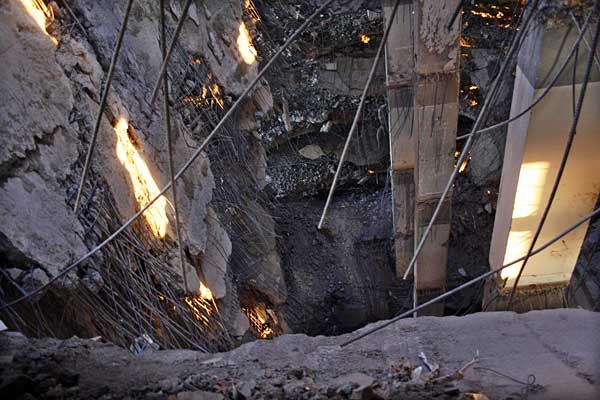 Collapsed floor of Rangs Building. December 9. 2007 ? Munir uz Zaman/DrikNews
Collapsed floor of Rangs Building. December 9. 2007 ? Munir uz Zaman/DrikNews
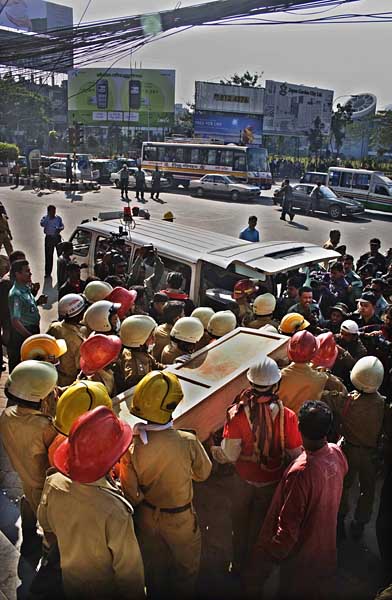 Body released by Fire Brigade being sent to morgue. ? Azizur Rahim Peu/DrikNews
Body released by Fire Brigade being sent to morgue. ? Azizur Rahim Peu/DrikNews
We rushed as soon as we received the tip off, sneaking away from our workshop on “Investigative Journalism for Television.” Working our way round the devotees praying on Panthapath we rushed to the National Museum.
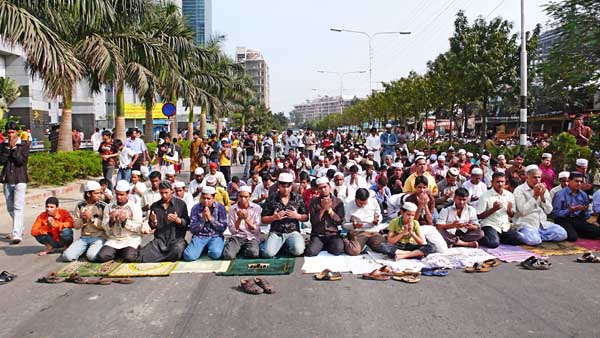 Jumma prayers on Panthapath. Friday December 7. 2007. ? Shahidul Alam/Drik/Majority World
Jumma prayers on Panthapath. Friday December 7. 2007. ? Shahidul Alam/Drik/Majority World
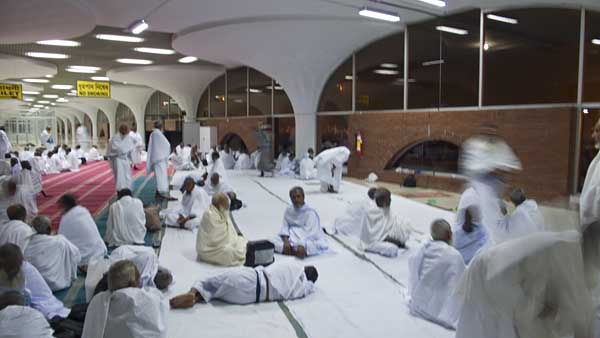 Hajis at Zia International Airport. Saturday December 8. 2007. ? Shahidul Alam/Drik/Majority World
Hajis at Zia International Airport. Saturday December 8. 2007. ? Shahidul Alam/Drik/Majority World
It was a false alarm. The trucks had left, and the artefacts that were still left in the National Museum were safe. At least for the moment. The remaining week, my book launch in Glasgow,
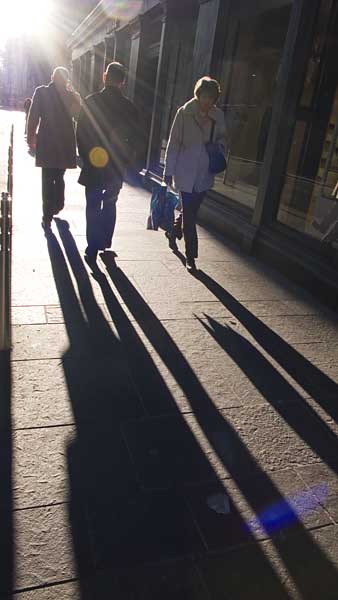 Glasgow. December 10 2007. ? Shahidul Alam/Drik/Majority World
Glasgow. December 10 2007. ? Shahidul Alam/Drik/Majority World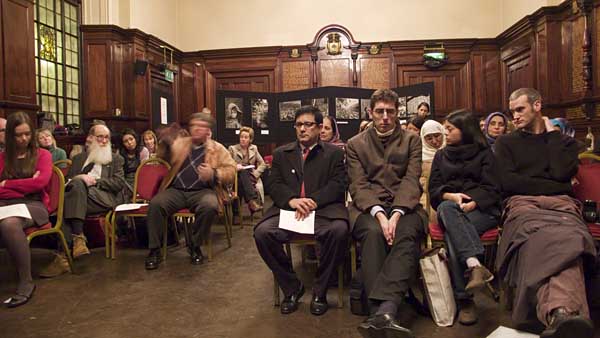 Glasgow. December 10 2007. ? Shahidul Alam/Drik/Majority World
Glasgow. December 10 2007. ? Shahidul Alam/Drik/Majority World
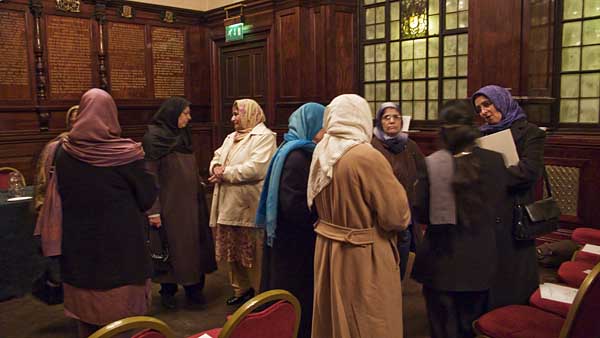 Glasgow. December 10 2007. ? Shahidul Alam/Drik/Majority World
Glasgow. December 10 2007. ? Shahidul Alam/Drik/Majority World
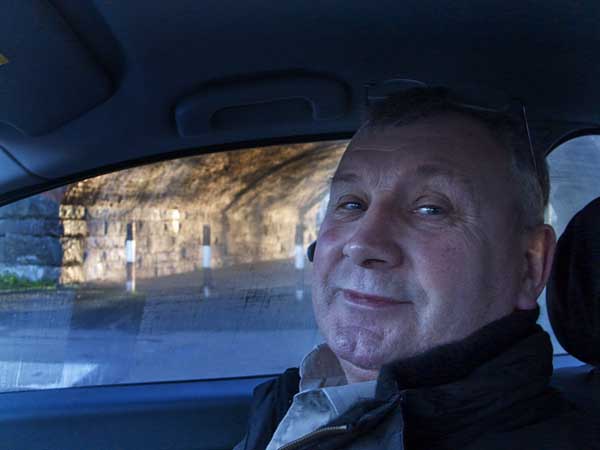 Taxi driver Robert who had worked at Port Glasgow. Ships later taken apart in Chittagong, Bangladesh, started their journey here. December 10 2007. ? Shahidul Alam/Drik/Majority World
Taxi driver Robert who had worked at Port Glasgow. Ships later taken apart in Chittagong, Bangladesh, started their journey here. December 10 2007. ? Shahidul Alam/Drik/Majority World
the Prince Claus Fund Award ceremony in Amsterdam and the conference “Visible Rights” at Harvard, took me from a sunny afternoon in Scotland to the snow covered streets of Cambridge.

Though Jon Husband had helped me setup my blog, I had never met him before. Jeroen picked me up at Schipol, and Jon, Jeroen and I had dinner at the Bazar Middle Eastern restaurant in Amsterdam. December 10. 2007. ? Shahidul Alam/Drik/Majority World
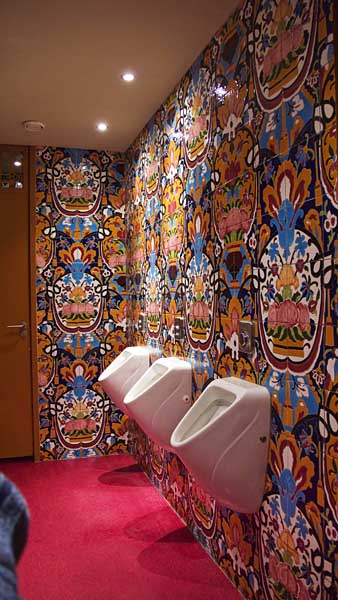 The ornate loo at the Bazar Middle Eastern restaurant in Amsterdam. December 10. 2007. ? Shahidul Alam/Drik/Majority World
The ornate loo at the Bazar Middle Eastern restaurant in Amsterdam. December 10. 2007. ? Shahidul Alam/Drik/Majority World
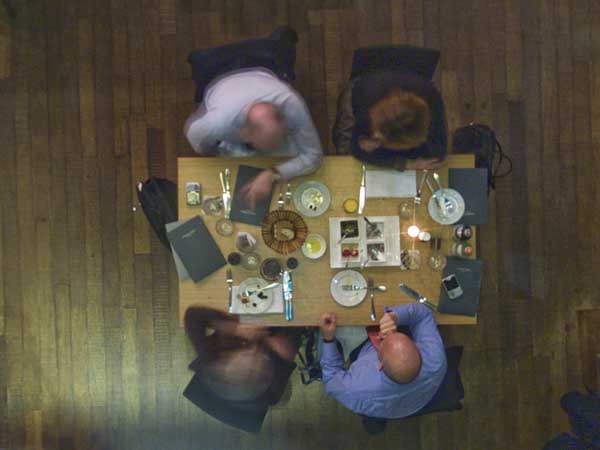 Diners seen through the glass floor at Muziekgebouw. Amsterdam. Dec 12. 2007. ? Shahidul Alam/Drik/Majority World
Diners seen through the glass floor at Muziekgebouw. Amsterdam. Dec 12. 2007. ? Shahidul Alam/Drik/Majority World
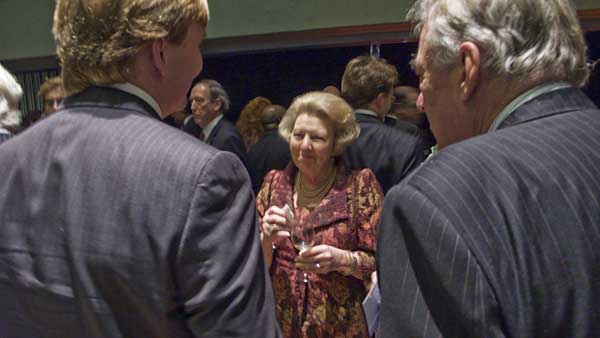 Queen Beatrix at Prince Claus Fund Award Ceremony at Muziekgebouw. Amsterdam. Dec 12. 2007. ? Shahidul Alam/Drik/Majority World
Queen Beatrix at Prince Claus Fund Award Ceremony at Muziekgebouw. Amsterdam. Dec 12. 2007. ? Shahidul Alam/Drik/Majority World
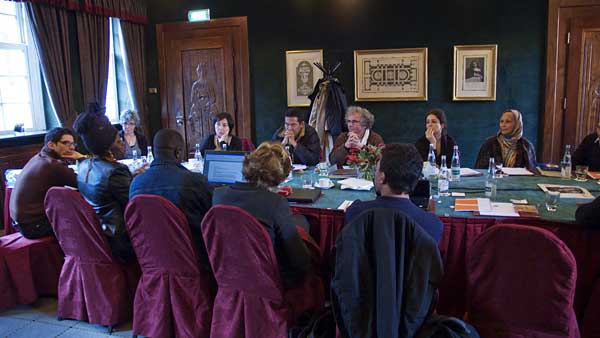 Network meeting of Prince Claus Fund at Grand Hotel, Amsterdam. December 13th 2007. ? Shahidul Alam/Drik/Majority World
Network meeting of Prince Claus Fund at Grand Hotel, Amsterdam. December 13th 2007. ? Shahidul Alam/Drik/Majority World
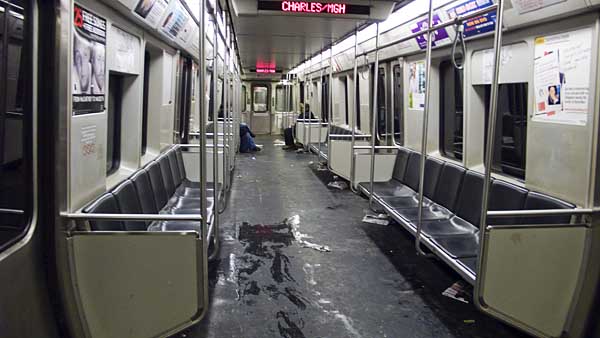 Train at Boston December 14. 2007. ? Shahidul Alam/Drik/Majority World
Train at Boston December 14. 2007. ? Shahidul Alam/Drik/Majority World
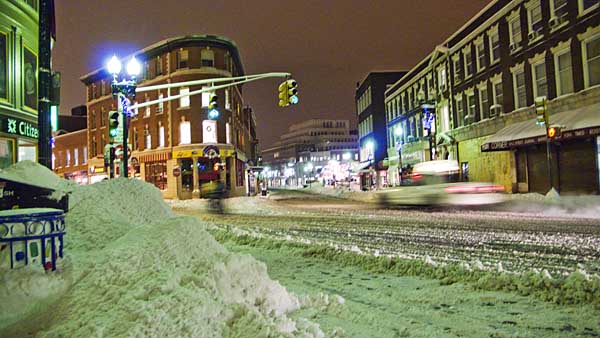 Outside Harvard train station at 2:00 am. December 14. 2007. ? Shahidul Alam/Drik/Majority World
Outside Harvard train station at 2:00 am. December 14. 2007. ? Shahidul Alam/Drik/Majority World
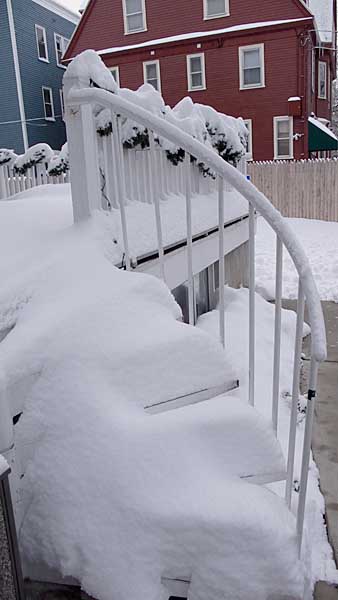 Stairs at Irving House. December 14. 2007. ? Shahidul Alam/Drik/Majority World
Stairs at Irving House. December 14. 2007. ? Shahidul Alam/Drik/Majority World
There was good news in between. The Rajshahi University teachers being released was a great relief, but the deaths of workers at Rangs Building, and the slum fire in Begunbari reminded me how far my own life was from the reality of workers and slum dwellers of my land.
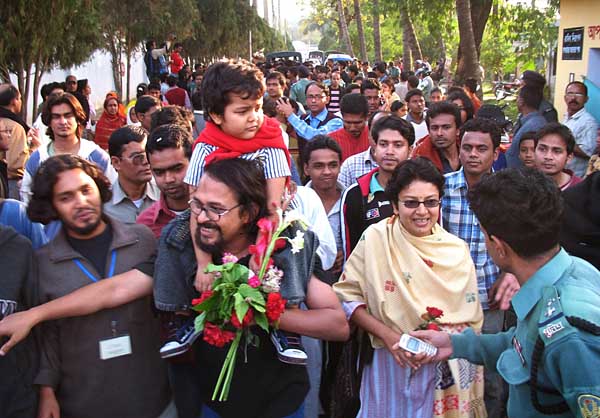 Detained Rajshahi University teachers, released after being granted a presidential pardon. December 10. 2007. ? Iqbal Ahmed/DrikNews
Detained Rajshahi University teachers, released after being granted a presidential pardon. December 10. 2007. ? Iqbal Ahmed/DrikNews
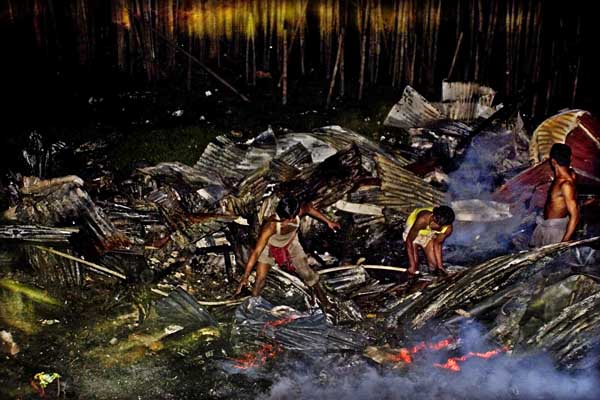 Fire in Begunbari slum. December 15. 2007. ? Zaid Islam/DrikNews
Fire in Begunbari slum. December 15. 2007. ? Zaid Islam/DrikNews
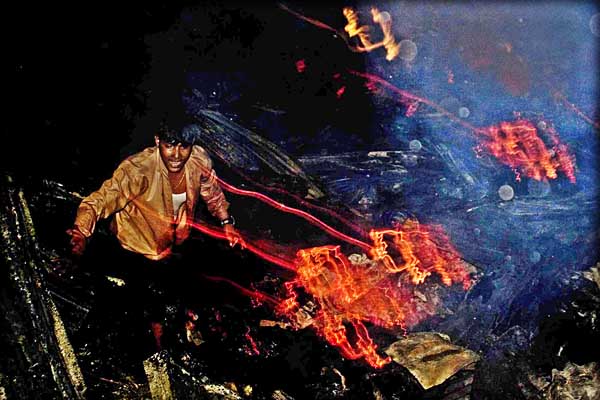 Fire in Begunbari slum. December 15. 2007. ? Zaid Islam/DrikNews
Fire in Begunbari slum. December 15. 2007. ? Zaid Islam/DrikNews
While the gatekeepers who rule our land remain untouched by the death of the poor. While media houses remain in the hands of wealthy business people. While opulent adverts by Grameen, Banglalink and Warid influence what gets reported in mainstream, the lives of media professionals like Priscilla Raj, Tipu Sultan, Probir Shikdar and Tasneem Khalil will continue to be under threat, The war criminals supporting the Pakistan Army had killed our intellectuals on the month of victory in 1971. December has another meaning for the workers and the slum dwellers who live under different military rulers.
Category: politics
The Candy Man
![]()
He was charming, witty, and took blame upon himself. Adviser Ayub Quadri, was the Minister of Education, Minister of Primary and Mass Education and Minister of Cultural Affairs, Government of the People?s Republic of Bangladesh. He was the perfect guy to rely upon for damage control. The public school background showed, as did the many years as a top bureaucrat. He had been a member of the elite Civil Service of Pakistan (CSP). An old boys network that still holds clout in the subcontinent.
The Press Information Department (PID) auditorium on the 3rd floor of Building 9, in the Bangladesh Secretariat was packed. Unlike many other Bangladeshi events this press conference started on time. Squeezing through the footpaths, crossing fences, lifting my bicycle over rickshaws stuck in traffic, I had panted my way to the secretariat. The police at gate 2 had been too perplexed by a bicycle going through the gate to even stop me for papers. I arrived just as the first question was raised. It was a packed hall, and while I thought I would stay at the back, I realised that I needed to get up there to stand any chance of getting a question in. I sat on the floor in between the video tripods.
The journalists had done their homework. And while there were a few questions that were repetitive, by and large, they knew what they wanted. In response to a question about the alleged corruption charges against one of the government officials involved in the transaction, the adviser joked. “Well I am the person in overall charge. The police don’t seem to be after me for corruption.” Pretty answer. Pity it didn’t answer the question.
The large table with the adviser in the middle was imposing. The Secretary of Culture on the left and another officer on the right played a largely ornamental role. So did the entire row of officials in the back. They did however lean forward to whisper in the adviser’s ear from time to time. The question came up of the alleged transportation of the bronze casket in 1959 to France, which Mr. Zakaria, the ex Secretary of Culture had mentioned in a press conference on the 1st December. The adviser let the question slip, saying he’d heard of such accusations and was looking into it. A member of the back row broke ranks and retorted, “There is no such record.” Mr. Zakaria, also an ex director of the department of archaeology, had mentioned a 49 year fight to get back this prized possession, without success. A journalist mentioned the case of the 30 paintings of Mohammad Younus. They had been sent to Yugoslavia, on a government to government exchange. None had ever come back. Quadri again said he didn’t know. “Don’t know” was quite a common response to questions. Candid perhaps, but not particularly useful.
In answer to the questions about the irregularities regarding the loan inventory, the adviser did provide figures, but no documents he could back them up with. Questions from the floor pointed to the disjoint between the figures he quoted and the ones given in the government documents submitted to the court. That they didn’t correspond to the inventory produced by the French themselves. He promised to provide updated documents this very evening. Tomorrow morning at the latest. Why the government had provided documents to the court which did not tally with the shipment, was a question that never got asked, and was certainly not clarified. The mystery of calling a press conference, but not having these documents at hand was never solved by the guests.
“I have full confidence that the items will come back.” He said, taking the weight of the world on his shoulders. As to why Bangladeshis should have confidence in him, was one that was never clarified.
“The company that had packed the crates have been doing so for 300 years,” he mentioned. The doubters have been asking for the packers to be named ever since the beginning, but have not been given an answer. Those who had thought the press conference would enlighten them were disappointed.
Since only government members of the committee were present, there was no one to question the claim that everything had been done to please the committee. That the committee had been fully satisfied with the proceedings. The fact that the official letter by the committee, in the hands of the press, said something entirely different was a mere technicality.
The inconsistencies were the problem. We still don’t know exactly how many items are being sent. Neither do we know exactly what is being sent. The few specifics the advisor provided, that there were “50 silver coins, and 8 gold coins,” might have helped in purchasing supplies for an Everest expedition, but didn’t help much in evaluating either the value, or the specifics of a museum item. Especially when the court record states “50 punchmarked coins” in one entry and an unspecified number of “gold and silver coins” in another. Assuming the number of silver coins in the latter entry is non-zero, and that the punchmarked coins are all silver, we still have a problem. The French inventory specifies “93 punch marked coins.” Are the “gold and silver coins” non-punchmarked? Do they add up to the “8 gold coins” the adviser was referring to? 50 + non-zero number = 50 and 50 + 8 = 93 in Ayub Quadri’s arithmetic.
There are bigger issues. He generally accepted that the insurance value was low, but claimed that it was an academic issue in the case of priceless items. Especially since he was confident that they were all coming back. However the French press release, issued on the 25th September 2007, stated that the insurance value was 4 million euro. The adviser today clearly stated 2.6 million euro. So who are we to believe? We are after all talking of the most prized possessions of a nation. Consistent statements help remove doubt. The adviser’s “confidence” might work on a poker table, but does little to put a worried population at ease.
He brushed off the accusation about whisking off the items in a hurry, or that there was any question of impropriety or stealth in terms of going against court directives. When asked why such an important event, which was covered by all major independent media, was completely unreported on state television, he smiled. The gentleman on the right did speak up this time. He pointed out that the question was “irrelevant.”
Other questions remain. Gold and silver coins is one thing. In the documents presented to the court by the government, even one of the most valued items, the large (and extremely rare) bronze statue the Vajrasattva does include an insurance value (not always the case for other items listed) of 200,000 euro. This item too does not have an accession number.
Quadri was unruffled throughout, never losing cool. Always extremely pleasant. His only admission to some concern was in answer to a question about when the items would come back. He said in no uncertain terms, “April.” He added, “Until then, I will stay worried, and looking at the mood in the room, I can tell that you too will not rest.” I hope he meant 2007.
As a child, we would watch the candy floss man take a tiny spoonful of sugar, a dollop of colouring and would watch with amazement as the machine spun out a pink web, which he would twirl around a stick. One portion was only dui poisha (two paisa). A figure which we could realistically save up. The large pink fluff, folded on contact, and melted in the mouth, but did give a sense of attainment. We called it hawai mithai, sweet made of air. This candy floss press conference too, had little substance but plenty of form.
Whether the media kids will feel they got value for their dui poisha is something we’ll see in tomorrow’s headlines.
3rd December 2007. Dhaka.
———
Previous governments have killed farmers when they demanded fertilisers and seeds. Villagers have been killed when they had the audacity to demand electricity, resist open pit mining. Yesterday 14 cyclone affected people were detained for trying to present a memorandum demanding relief. We wonder what demands for saving our heritage will bring.
The Missing Piece of the Jigsaw
![]()
The battle lines appear to have been drawn. Guimet is a respected museum, and there has been natural interest in a show that should be very special. Why then such resistance from art lovers of Bangladesh? Surely art is to be appreciated? It is part of our identity and an important part of the image we portray. Why on the other hand, the secrecy? The organisers should be taking credit for arranging such an event and not trying to sneak away under police protection. If there is nothing to cover up, why the covert operation?
The emotions are high. I’ve seen people weeping because something very special to them has been taken away. I have seen people angry because they feel violated. I have seen people frustrated, because they feel helpless against the power of the establishment.
As a journalist I need to be wary. It is important to separate the emotions from the facts. To not let friendships sway one’s judgement. To apply journalistic rigour in one’s analysis regardless of whether one agrees with the outcome of one’s research.
So let’s separate the facts from the opinions.
The Guimet is a respected museum known and admired. The protesters are respected citizens with a high level of credibility. Questions have been raised about both entities, which we need to address further, but there appears to be a gap in the puzzle, which no one so far has discussed. The answer could perhaps provide a vital clue.
What was the motive behind the exhibition and who initiated it? Who are the stakeholders? The interest of Guimet is understandable. Leaving aside the accusations for the moment, an important museum specialising in non western art would surely have an interest in such a prized exhibit. But would a museum, knowing there is so much resistance, and bad press, insist upon such an exhibit coming, when so many other options are available? Major museums are usually booked way in advance. The opening dates for this one is also well past. We have Christmas and New Year coming up. Setting up the show, once the entire shipment has arrived, will take another three weeks by the director’s own admission.
We have been repeatedly told that the event is in the interest of promoting the image of Bangladesh abroad. Having put in the huge amount of work and expense that has gone into the curatorial process, does it really make sense for the French Government and Musee Guimet to take on such flak? Does it make sense for the French Government and the Museum officials to demonstrate their love for Bangladesh, when Bangladeshis themselves are opposing the event so vociferously?
While exploring these options I have come across several opinions. One states “The truth is that that some quarters in Bangladesh are upset that the items to be shown are Hindu art artifacts and that this exhibition is going to send the wrong image of Bangladesh to the French public: that Bangladesh, a majority Muslim country, has a strong Hindu culture and art history. This is the real story not the bullshit that has been published. How come knowledgeable sources in Dhaka write to me to tell me what they know for sure and not to you?”
Another friend said “The majority of the works are fakes, and taking the show to the Guimet would reveal this fact, exposing the perpetrators. Hence the resistance.” This too is attributed to knowledgeable sources. None of the people who tell me these stories will reveal who these knowledgeable people are.
Sitting in the comfort of the French Ambassador’s residence we heard him say, “Some people who wanted a good image of Bangladesh had promoted the exhibition.” By implication, this was something the protesters were not inclined towards. So the love of the nation, or lack of it was his criterion for determining which side of the divide one would stay. And who are they? He too was reluctant to reveal who these good people were. I suppose good people are by nature modest, and unwilling to take credit for their virtue.
It doesn’t take deep analysis to see that none of the accusations hold. So we are still grappling with the motive. Not of Guimet itself, but of the ‘some’ people that the French Ambassador has repeatedly alluded to.
There was another event “Sonar Bangla Fair” which was planned as a conjunct to the Guimet exhibition. While both the government and the French embassy have denied direct ties to this event, it is clear from the many circulars and press releases that have gone out, that the Guimet exhibition was part of a package. The extensive lobbying, the pressure applied to media houses, and the behind the scenes manoeuvres through which people have been told to ‘drop’ the case, has come not so much from the French, but from highly placed Bangladeshis. Is it their love of Bangladesh that is the driving force? Is love for their country something they should be so secretive about?
The protesters have been very open about their position and have stated so through their physical actions and their statements. Independent bloggers from both sides of the camp have expressed their opinions openly. Why have the promoters of this exhibition, with access to both the government and the embassy, chosen to work strictly under cover? The planning for this exhibition has been going on for a long time. As in many a Bangla romance, the promoters’ unrequited love has been a well kept secret, but it has survived a change of government.
The recent statement by prominent citizens to the French Government, shows a disturbing turn in the position taken by the protesters. “While we were originally open to the idea of showing the work at Musee Guimet provided the transparency issues were addressed, the recent actions of the museum has removed any semblance of trust in the organisation, and we are no longer willing to loan our prized possessions to an organisation with such standards of behaviour. The incident, originally restricted to the issue of an exhibition now appears to have created a general distrust in the French government amongst the Bangladeshi public.”
How come these well wishers of Bangladesh risk alienating the very public that they love so dearly, but are still shy about declaring the love for their country?
I believe one important word that has so far not been uttered is ‘money’. What is the ‘package’ that the Guimet exhibition falls under? How much money is involved? Who are the beneficiaries, and how were they chosen? Who are they affiliated to?
The government in power has made corruption their number one target. Business people, prominent politicians and even ordinary citizens have been asked to declare their assets and their links to financial ventures. Perhaps it is time for the government to ask all the people who are linked with Masterpieces of the Ganges Delta exhibition, the Sonar Bangla Fair and all the ancillary events to declare the extent of their association and the monetary value that such association brings. Citizens have been asked to help the government by reporting any suspected cases of corruption. With activities of the Ministry of Culture itself in question. With the government appointed committee complaining of non-cooperation by Culture ministry officials. With people chanting chor chor (thief, thief) in the streets outside a public institution, why has the government suddenly gone blind? Have the sniffer dogs of corruption, who bark at the slightest whiff of a nexus, suddenly lost their sense of smell? Or would that be a same side (own goal)?
Perhaps this piece of the jigsaw will help us see the full picture.
—————————————————————————
12:40 am 3rd Dec. The Government has finally responded. Press conference called by the Ministry of Culture at 12:00 pm. Building 9. Bangladesh Secretariat.
The Price of Priceless Objects
![]()
letter-to-the-french-government.docStop Press: Ten crates containing rare archaeological treasures of Bangladesh have been bundled out of the national museum and are said to be bound for Guimet Museum in Paris, via flight AF 6731 (dep: 1205 Saturday 1st Dec 2007). Preparations had been made to secretly remove the items through a shipment order by the French Embassy made to Homebound Packers and Shippers. Trucks and forklift arrive secretly in museum in early hours of morning. But the news leaked and media professionals and protesters gathered outside the museum. Under heavy police presence Homebound vehicles (Dhaka Metro Umo 11-0814, pho 11 3634, U 14 0187) and fork lift trucks all bearing “Save The Children and USAID Cyclone Sidr Emergency Relief ” signs were used to remove the priceless items. Predictably, and as in the case of all previous authoritarian governments, while the story was the lead news in all major newspapers and independent television channels. BTV the state run television channel which is the only terrestrial channel in Bangladesh, failed to report the incident altogether.
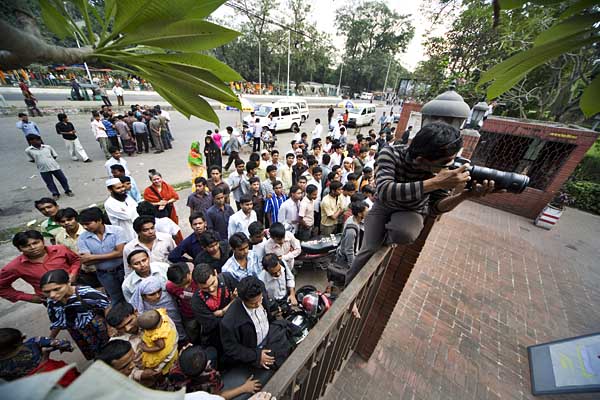
Protesters and media professionals watching as crates get loaded onto Homebound trucks. ? Shahidul Alam/Drik/Majorityworld
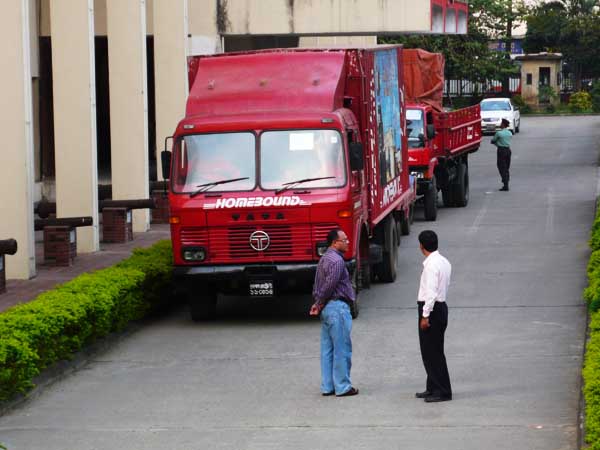
Homebound trucks preparing to leave National Museum. ? Shahidul Alam/Drik/Majorityworld
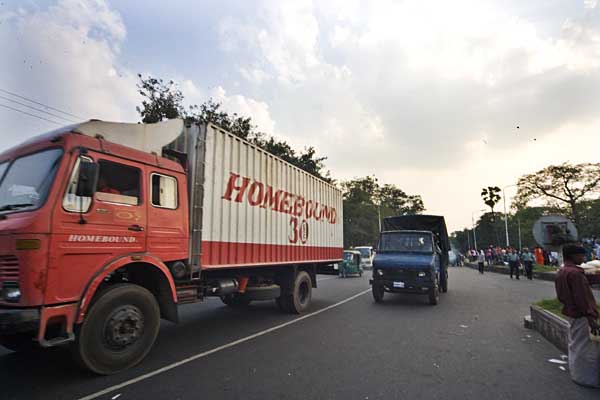
Trucks being escorted out of National Museum by police. ? Shahidul Alam/Drik/Majorityworld
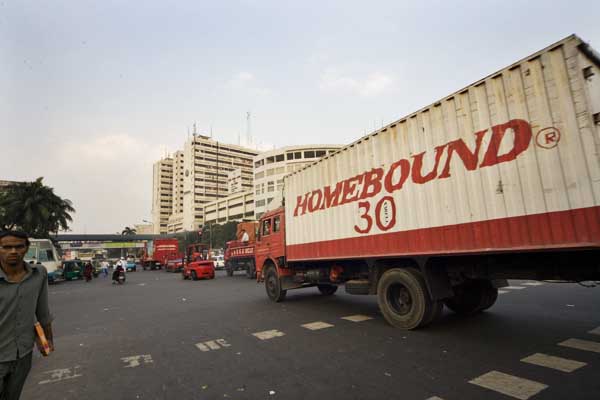
Homebound convoy heading to airport. ? Shahidul Alam/Drik/Majorityworld
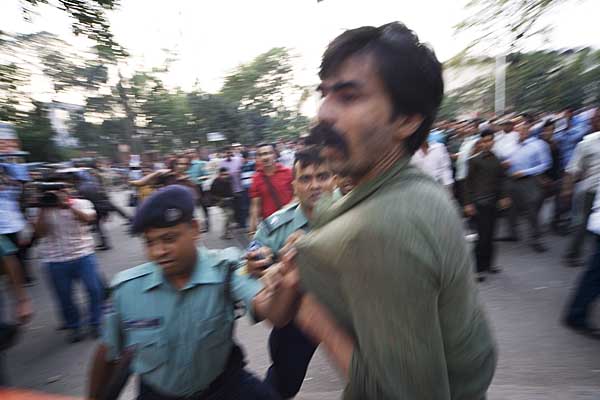
Police arrest Shekhar Shaswata. ? Shahidul Alam/Drik/Majorityworld
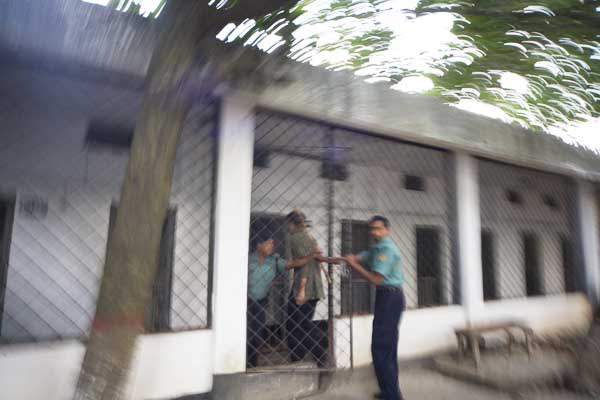
Shekhar being taken into custody. ? Shahidul Alam/Drik/Majorityworld
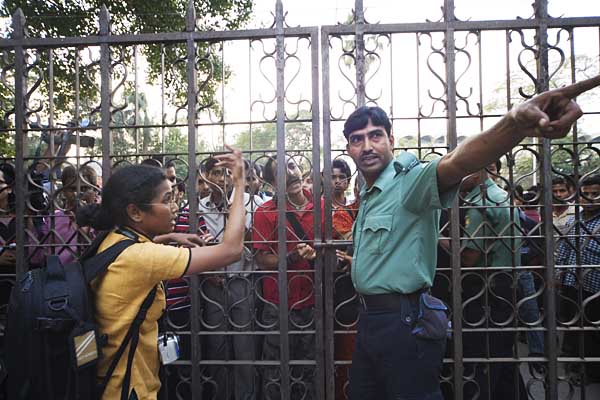
Media professionals demanding to be let in. ? Shahidul Alam/Drik/Majorityworld
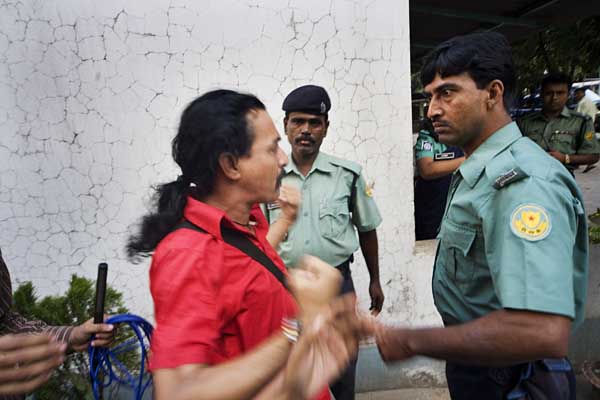
Further clashes with police. ? Shahidul Alam/Drik/Majorityworld
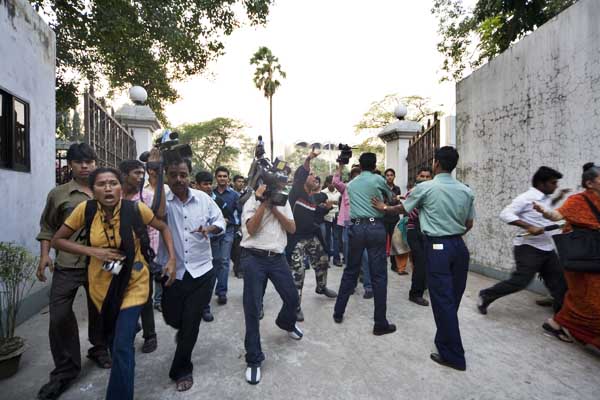
Media storm into Shahbagh police station. ? Shahidul Alam/Drik/Majorityworld
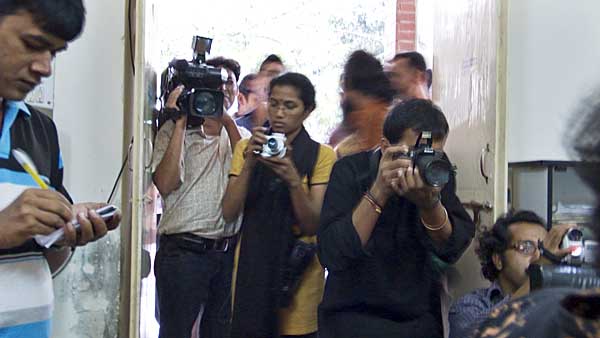
Media in officer Morshed’s office. Morshed claims he knew nothing of what was going on all day across the road. ? Shahidul Alam/Drik/Majorityworld
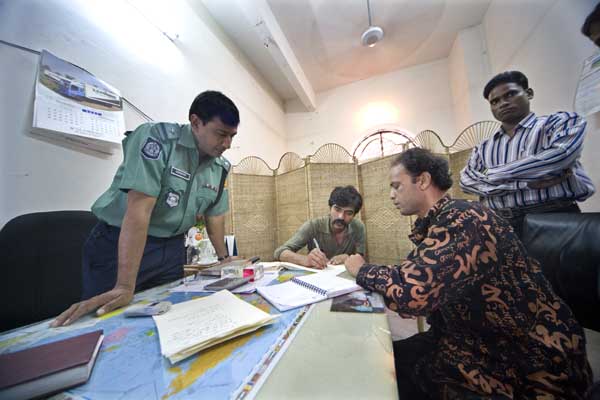
Shekhar being released upon signed undertaking by those demanding his release. ? Shahidul Alam/Drik/Majorityworld
Protesters clashed with police. Shekhar Shashwata was arrested, and some media professionals roughed up. Eventually protesters were able to get Shekhar released. Police officer Morshed who made the arrest, claimed he “knew nothing about what was happening across the road.”
The lack of transparency surrounding the exhibition has led to huge controversies where leading citizens have demanded that the government and the French Museum allow experts to inspect the items being taken away. Past allegations of art objects having been taken to France and never returned have increased the suspicion.
While the government has appointed a committee to investigate the matter, in an unprecedented move, government and French Embassy officials have, without informing either the committee or the media, taken the items out of the museum in what resembled a police protected museum robbery.
Protesters are asking international media to disseminate the news, and prevent the artefacts from being taken away in this manner. Bangladesh is under emergency rule where protests and gatherings of any form are illegal, and police have wide ranging powers. After a recent unrest at the universities arrest warrants were issued against 8,300 largely unnamed people. Teachers, students and university employees arrested after the event are yet to be released. There have been accusations of torture in custody.
———-
Earlier on in the day:
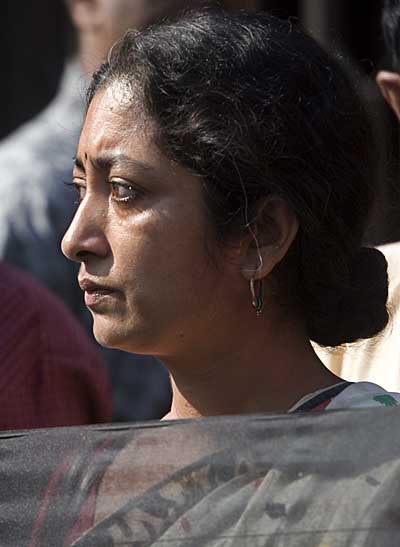
Above: Tearful protester outside museum at 10:15 AM 30th November 2007. Below: Homebound truck with Cyclone Relief sign outside museum.
? Shahidul Alam/Drik/Majorityworld
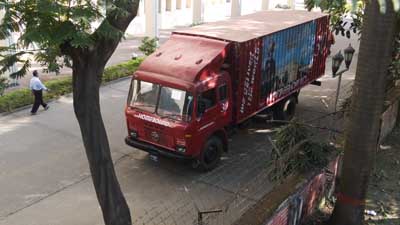
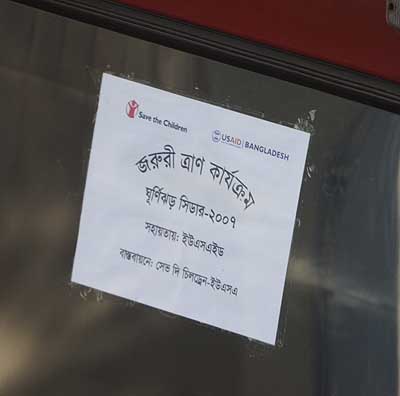
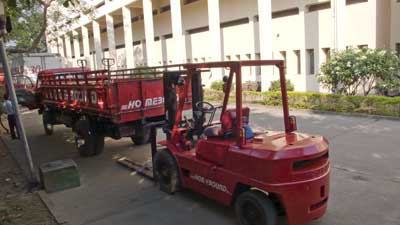 Forklift on standby
Forklift on standby
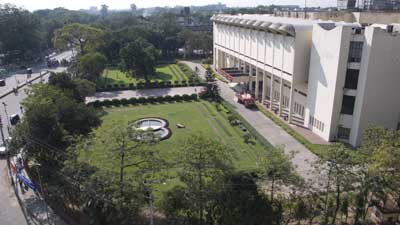 Forklift in front of Museum
Forklift in front of Museum
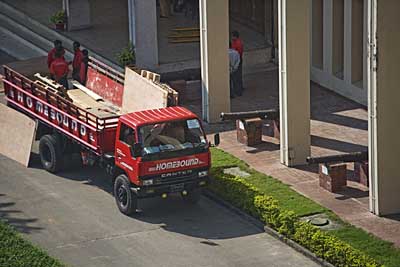 Homebound in line of fire
Homebound in line of fire
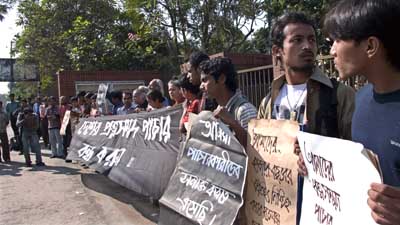 Protesters outside museum
Protesters outside museum
Video of protests. ? Rabeya Sarkar Rima/DrikAV
The background to the story by Anisur Rahman
Letter to the French Government by prominent citizens
1st Video Clip of Protest Press Conference. ? Naeem Mohaiemen
2nd Video Clip of Protest Press Conference. ? Naeem Mohaiemen
———————————————————
The Price of Priceless Objects by Shahidul Alam
This was breaking news. Shishir Bhattacharjee, Nisar Ahmed and Rahnuma were racing against the clock. The pukur churi (daylight robbery, lit: pond stealing) had to be stopped. Bangladesh is awash with conspiracy theories and I needed to be convinced that something irregular was really taking place. A major exhibition of Bangladeshi heritage in a well-known western museum seemed a good thing. I wanted hard facts. Facts emerged, and eventually tumbled out.
The issue in question was a proposed exhibition at the Mus?e National des Arts Asiatiques – Guimet, in Paris, where some of the most prized archaeological objects collected from the five major museums would be on display in an exhibition announced on the Museum website as “Masterpieces of the Ganges delta. Collections from the Bangladesh Museums.” The only suggestion that things might not be going entirely as planned came from the notice “dates to be confirmed.” The France Guide still lists the original dates: 24/10/2007 to 03/05/2008.
Doubts had been raised about the transparency of the process through which the exhibition had been arranged. With leading national experts calling for a stay order and the court requiring the government to demonstrate that due process had been maintained,
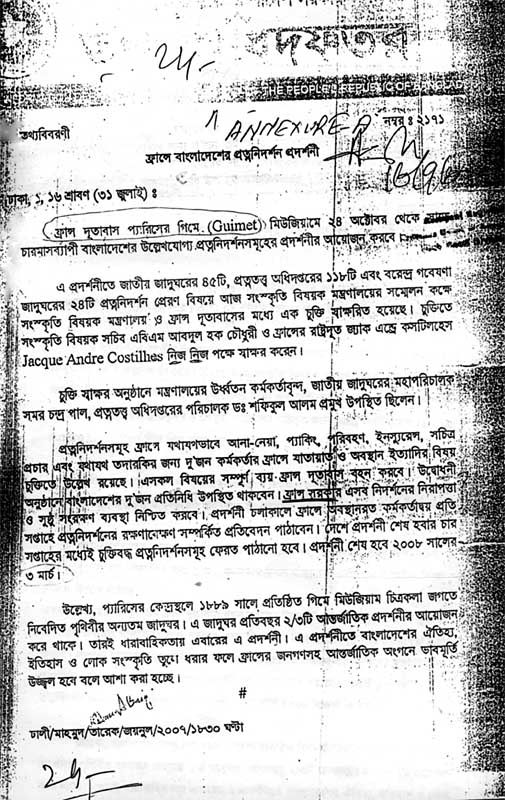
things were getting murky. A hastily called press conference by the French Embassy landed them in further trouble. The Ambassador was promptly withdrawn. Unconnected some say, but unusual in a country where the departure of western ambassadors is generally accompanied by considerable fanfare.
“Some Bangladeshis who want to improve the image of Bangladesh abroad have been supporting the exhibition”, the new ambassador stressed. The suggestion that the Bangladeshi experts who had questioned the intentions of this prestigious museum and the French government itself, and even had the audacity to suggest that the French might possibly have intentions not entirely in keeping with Bangladeshi interests, were unpatriotic, was perhaps unintentional.
Not a hair on Sita’s head was singed as she had walked through the flames. But she had been doubted, and she felt only the test of fire could prove her innocence and her loyalty. Who is loyal to Bangladesh is now the question. Protagonists of the proposed exhibition at Guimet promptly dismissed the ones who demanded transparency, as Talibans and enemies of the state. My beard didn’t help.
The fact that these very experts had over the years been the mainstay of collecting, creating and nurturing these collections, didn’t appear to affect the French argument. Given Kwame Opoku’s recent statement “Mus?e Guimet in Paris which incidentally also holds thousands of stolen/illegal objects from China and the rest of Asia,” one would have expected the French to be more concerned with damage control.
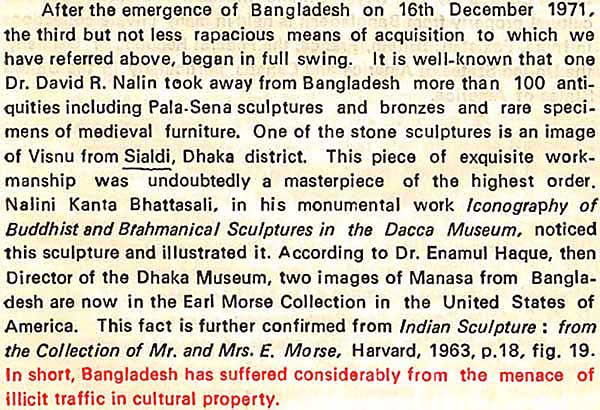
Extract from “The Museums in Bangladesh” by Firoz Mahmud and Habibur Rahman from the chapter initiated by the “Ad Hoc Committee on the Return and Restitution of Cultural Property to its Countries of Origin” set up by the International Council of Museums ICOM. Page 487.

Extract from list of organisations and locations where stolen Bangladeshi cultural property have been illegally taken. Page 488
Or was this an attempt to gain what they could before the cat got out of the bag? Els Van Der Plas, the director of the Prince Claus Fund in the Netherlands, held Guimet in high regard and had respect for the director. June Rollinson of the British Council in Dhaka, also spoke highly of the Guimet. Mark Haworth-Booth, former senior curator of the Victoria and Albert Museum in London, was an old friend and had been a guest teacher at Pathshala. He fully supported museums lending work to each other but felt a shared copyright of the photographs (the contract gave Bangladesh no rights over the images of the artefacts) would have been the normal practice.
However it was Mark’s comment “I do not think that professionally-run museums would lend an object if it had no accession number” that got me going. The appendix listing the items, obtained by court order, was a farce. The number of items varied in different reports. We managed to obtain the French internal listing which had 20 more items than the Bangladeshi list. These had been obtained in a joint excavation (France and Bangladesh) in Mahasthangar, and were all marked ‘reserved’. Items had been clumped together without individual listing (e.g. ’93 punch-marked coins’). Insurance value was sometimes missing. The basic documentation of a normal museum inventory, like period, condition and markings were missing. A large number of items had no accession numbers. And this was a listing of the most precious items belonging to Bangladesh, many of which Bangladeshis themselves had never had the opportunity of seeing! Not even the nation’s leading scholars, researchers historians or archaeologists. Certainly, it was the Bangladeshi side that should have provided these details, but with UNESCO stressing ‘due diligence’ on the part of the borrower, to accept such a precious consignment on the basis of such flimsy documentation, was fishy. More importantly, there was no way in which even the most diligent officials could verify that the objects lent, were indeed what had been returned.

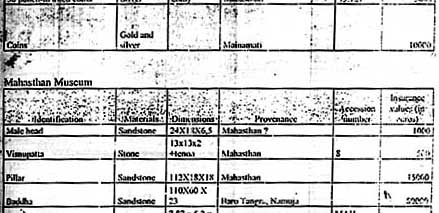
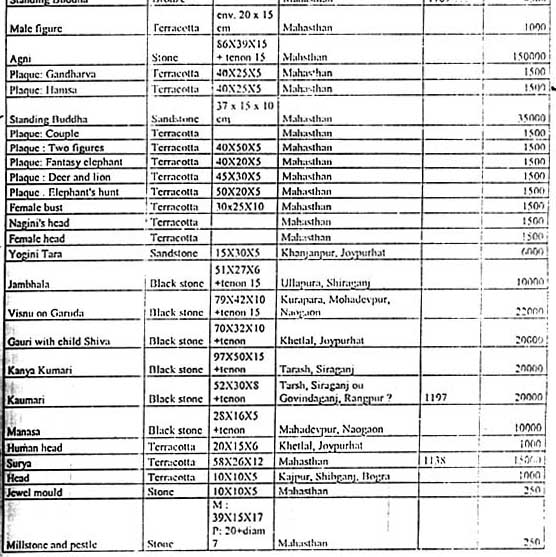

This was what the French press release had insisted was ‘complete documentation’.
When Jos van Beurden sent me his soon to be published article “Diplomats and smuggling of art” providing extensive and well documented instances of how majority world countries had their art objects stolen by wealthier ones via diplomats, it appeared as if it is the image of France and not of Bangladesh that needs rescuing.
With some juggling of schedules, I was able to combine a trip to Paris to show a newly made film, with the possibility of a trip to the Guimet.
Mus?e du quai Branly, the museum inviting me, was also on the ‘wanted’ list put together by Opoku and others. I needed no further convincing. I was off to Paris.
Quai Branly had sent a car to pick me up from Charles de Gaulle airport, and it was with considerable curiosity that I asked the driver what he thought of the Guimet Museum. Xavier had never heard of the place. I must have been unlucky with my driver, for Michel Philpott of Le Monde du, who had invited me, did indeed know the Guimet. It was perhaps not amongst the finest in the world, but still an important museum. It was also within walking distance.
The following morning, my Armenian photographer friend Ruben and I decided to pay the Guimet a visit. I had my HDV video camera with me. I had done a few other things in preparation too, like writing to the press officer Helene Lefevre, asking for an appointment. She did respond to my mail, but no appointment had been granted. I had been concerned that the Bangladeshi government had no rights over the photographs taken by the French photographer, but a mail to him also failed to elicit a reply. So Ruben and I were taking our chances. With my own work having been shown at the Centre Georges Pompidou fifteen years ago, I thought I had the credentials as an artist. I also had my press pass.
Crossing the Seine on a sunny Paris day, looking back at the Eiffel Tower, walking through the manicured pathways with Parisians striding by in their haute couture, I could picture Doisneau photographing the famous kiss.
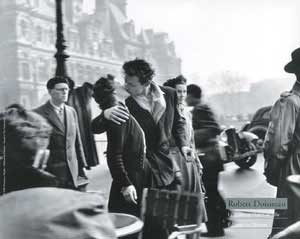
The Kiss. ? Robert Doisneau/Magnum
Finding the museum in the busy Paris map was not easy. Tucked away in the edge of a roundabout in Avenue D’Iena, was our famous Mus?e Guimet. Two homeless people had camped outside on the footpath, and children were having lunch on the short staircase. This represented the reality in all our countries but is distant from the image the establishment generally tries to provide.
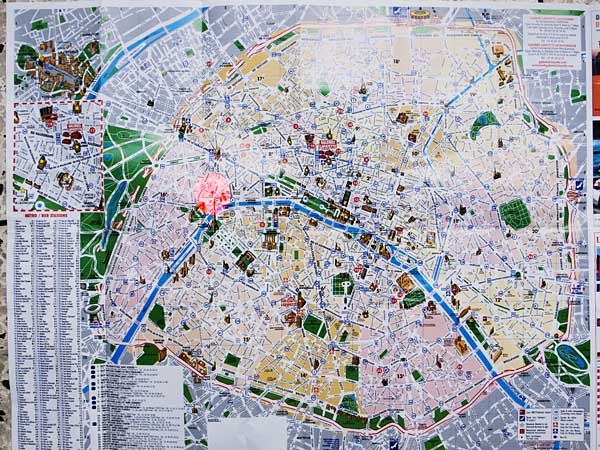
Map of Paris. Guimet Museum shown as small dot in centre of red circle.
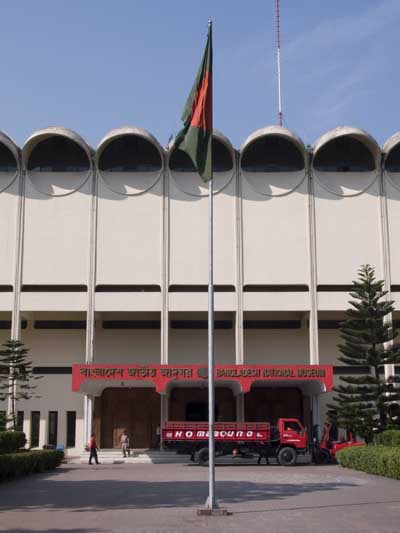

Left: Homebound truck loading outside Bangladesh National Museum 11:15 AM 30th November 2007. Right: Homeless people outside Guimet Museum. Paris. France. 31st October 2007. ? Shahidul Alam/Drik/Majorityworld
I felt at home as I walked through the small entrance. This was far less pretentious than our own national museum. The informality of the place was comforting. The elderly gentleman beside us as we stood at reception overheard me asking about the Bangladeshi exhibition. Speaking with an American accent he remarked on what a fine show it would be. “It was taking time, but it would definitely be there.”
I was in journalist mode, and having discovered that he was Ambassador Dean and a board member of Guimet, gently led him on to the sort of work the museum was known for. He pointed out that the museum had just restored the head of a Cambodian statue to its body after 500 years. “Where was this statue?” I asked in as innocent a tone as I could muster. “Right here in this museum” was the proud board member’s reply. The head that was France’s gain, was presumably Cambodia’s loss.
I was lucky. Both the director of Guimet Jean-Francois Jarriage and the curator of the show Vincent Lefevre, were available that day, and didn’t appear to have any appointments at that time. I handed over my card, and spoke to Anna the director’s secretary, over the phone. She hadn’t seen my card then, but when I explained over the phone that I was from Bangladesh, I could sense a chill. Suddenly everyone clammed up. Neither the director nor the curator was able to see me, and no one in the museum would make any comment. Perhaps it was years of colonialism that had shaped our behaviour, or our rustic mannerisms of hospitality. I couldn’t help wondering how a visiting journalist who had arrived at the doorstep of any of our museums, would have been drowned with cups of sweet tea laced with condensed milk by the time the director had come over.
It was only a month ago when I had walked through the national museum at Siem Reap, aghast at the rows of ancient Cambodian statues whose heads were missing. One wonders where the heads have landed up. Ambassador Dean’s quest for restoration might just result in Guimet’s acquisition of the remainder of the bodies.
“Masterpieces of the Ganges delta.” France’s gain, Bangladesh’s loss?
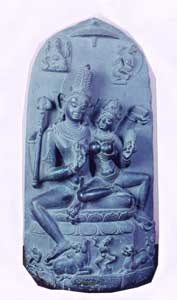
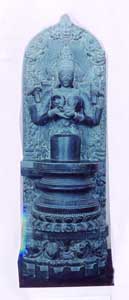
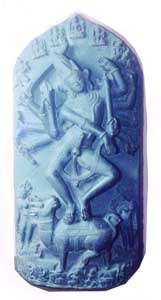
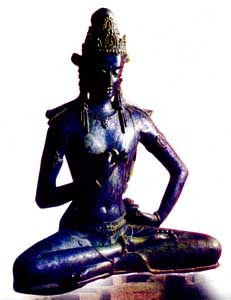
Some of the rare sculptures being taken to Guimet Museum
Article by Kwame Opoku
Just Hand Me A Biri
![]()
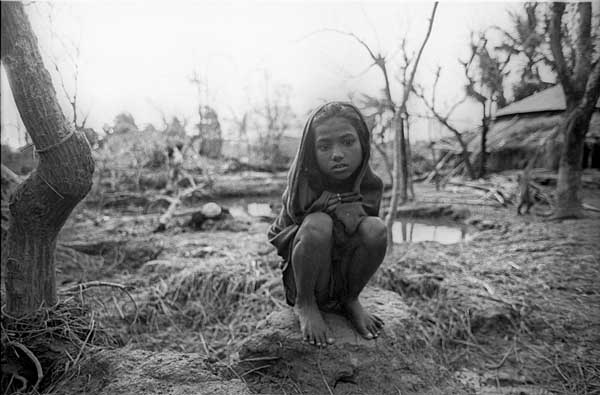
Orphaned girl by the remains of what was her home. Anwara. Bangladesh. 1991. ? Shahidul Alam/Drik/Majority World
“The dark cyclone shelter was packed with people, mostly women and children, some crying, some screaming. It was chaos. And then there was the loud knock. We struggled to open the door against the wind, The whole night sky tried to get in through the small gap we had made. The man pushed his way in as we struggled to lock the door again. He was a strong burly man, but he was shaking. “Give me a biri (hand rolled cigarette)” he said. I got angry. “Can’t you see what is happening here? What state people are in? And you want a biri?” He wasn’t harsh, but his stare was cold. “Agaro jon re puita aisi. Biri de.” (I’ve buried eleven. Just hand me a biri).”
This had been 1991. We had crossed into Hatia, and the ride across the choppy sea had left us all rattled. Slowly people spoke of their experiences on the night of the 29th April 1991, when the sea had become a wave.
This time I was stranded in Kathmandu when I received the news from Rahnuma. She was dreading the worst. The ticker tape on CNN said the storm was 100 kilometres from Dhaka, when I finally went to sleep in the early hours of the morning. This was the time of Internet and mobile phones, but the Net was down and the network was too congested to get calls through. Irfan managed to send a text the next day asking me to charge my mobile. Dhaka had no electricity.
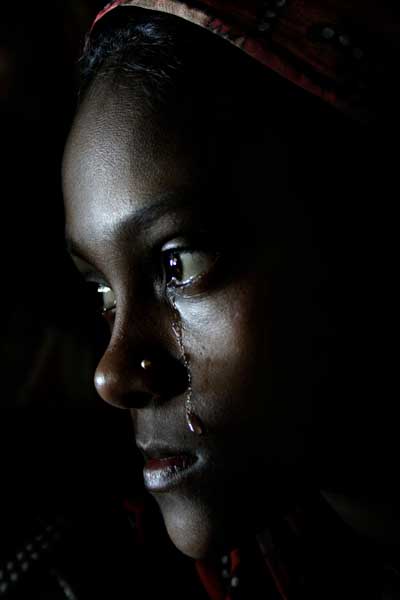
Cyclone SIDR. Dublar Char, Bagerhat, Bangladesh. November 26 2007. ? Asad/DrikNews
Joshim was waiting as usual at the airport. At least there was electricity there. Some of the street lamps were lit. I managed to make it home in the early hours of the morning. Most of Dhaka was then in darkness. We did have electricity in the flat, but it soon went. Ragni and Nunni (two of our many children) were both fast asleep. Ragni went off this morning to an FK meeting, an exchange partnership we are involved in. The Net is up again, at least partially. Nipun is designing the majority world flyer. Life goes on. We don’t yet know the extent of the damage, but the figures are undoubtedly high. We are fine. Many others sadly are not.
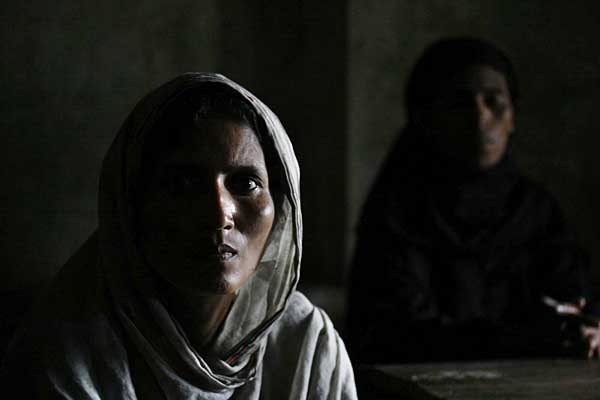
Women in a cyclone shelter centre at Coxbazar, Bangladesh. Cyclone SIDR. November 16 2007. ? Munir uz Zaman/DrikNews
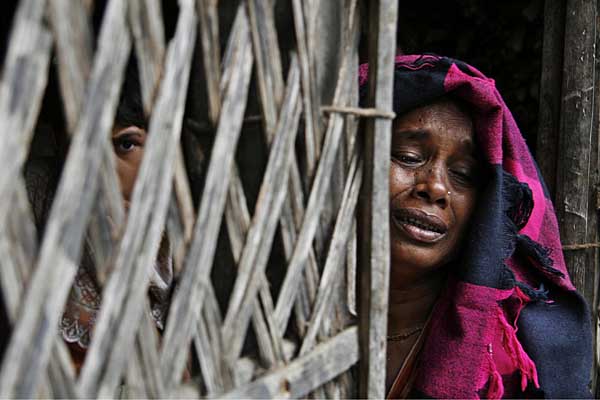
A woman weeps for her lost relatives. Cyclone SIDR. Khulna. Bangladesh. 17th November 2007. ? Tanvir Ahmed/DrikNews
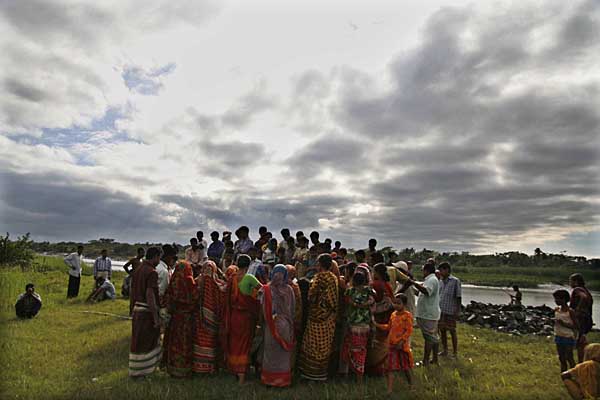
Relatives and neighbours bury their dead by the Rupsha River. Cyclone SIDR. Khulna. Bangladesh. 17th November 2007. ? Tanvir Ahmed/DrikNews
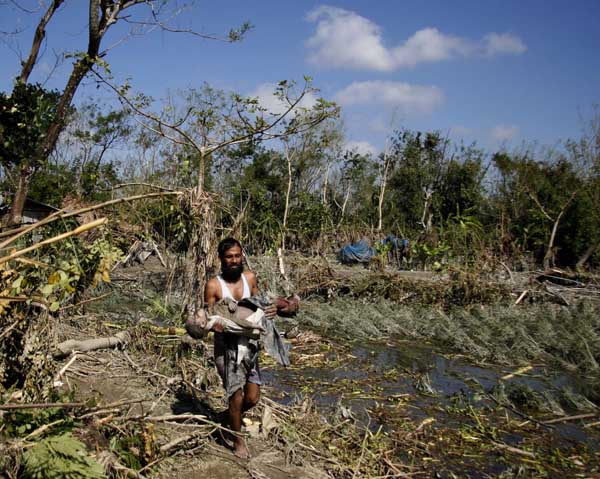
A man carries his grandchild?s dead body from debris of the house. Cyclone SIDR. Shoronkhola, Bagerhat, Bangladesh. November 19 2007. ? Tanvir Ahmed/DrikNews
My bike was at Drik, so I took a rickshaw to the office. The rickshawalla’s name was Shah Alam. Our similar names added to our camaraderie. He was from Bhola. They had lost twelve. “But I have a mobile” he said sheepishly. Almost apologising for this perceived opulence. “At least this way I can talk to my parents.”
Abir and Munir are already out there. Jessica is preparing to leave for Patuakhali. In 1991, I had rushed back from Feni and managed to bluff my way into a military helicopter to do a story with Barbara Crossette for the New York Times. Sending the picture through the old fax transmitter in the T&T office took hours. With most connections down, we had struggled to get the picture through. And then I was out again. It was only when I met James Nachtwey in Chittagong that I found out that my picture had made the front page of the Herald Tribune. Now as I sit behind a computer screen typing text and booking tomorrow’s flight to Sri Lanka, other photographers are headed for the coastline.
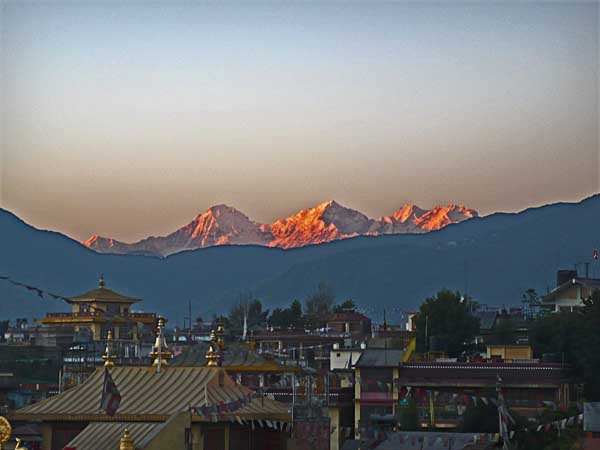
Sunset on the outskirts of Kathmandu. Nepal. 16th November 2007. ? Shahidul Alam/Drik/Majority World
Last night as we waited for yet another hugely delayed GMG flight, Nayantara took Tutul and I to catch the last glimpse of sunlight in the mountains outside Kathmandu. The chanting of the priests, and the gentle bells from the stupa below made Dhaka seem far away. We even stopped to give an interview on CJMC’s new FM station. Back home Bazlu bhai and his team have been pushing for permission for community radio for years. A much needed tool in times of crisis. The airwaves here have been reserved for propaganda. A once outspoken media sings the glory of the military and the untiring efforts of the government. Some with reluctance.
Saving people’s lives seems a far lesser priority.
——
Find link for interview on Radio France Internationale (streaming)
Afsan Chowdhury’s interview on climate change in Bangladesh
or download file: sa-2nd-clip-from-french-radio-on-cyclone.mp3
article-on-natures-fury.pdf (from the Book: Communicating Disasters, by TVEAP and UNDP)
Bangladesh Now
![]()
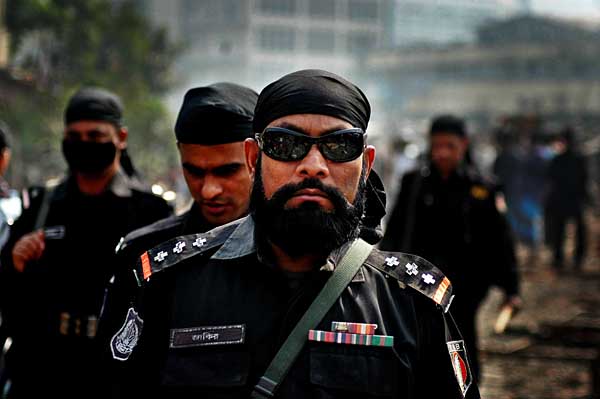
The Rapid Action Battalion (RAB) were setup as a crack team to support law enforcement. Numerous accusations of extra judicial killings have been attributed to RAB, usually followed by a government press release about people having died in a ‘crossfire’. ? Munem Wasif/DrikNews
Dark glasses, black bandana, arrogance in his face. ‘The Protector’ strides with purpose. A new word enters our lexicon. You can now ‘crossfire’ a person. No questions asked.
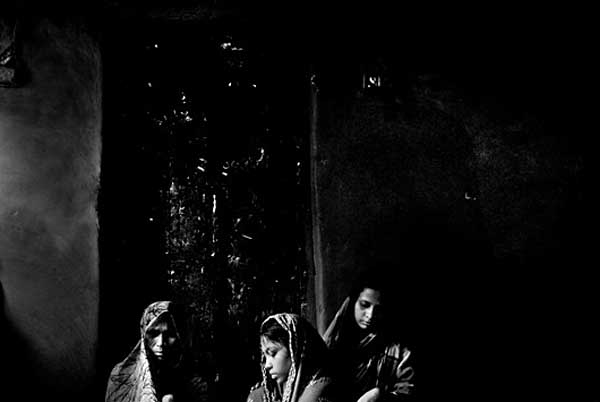
Hanif, a mill worker, was shot dead by the police during a protest rally organised by the workers. Two hundred workers were injured. Crescent jute mill, Khalishpur, Khulna, 11 September 2006. ? Munem Wasif/DrikNews
She mourns in silence. Her man, a worker in a mill, is no more. His crime? Demanding payment for his labour.
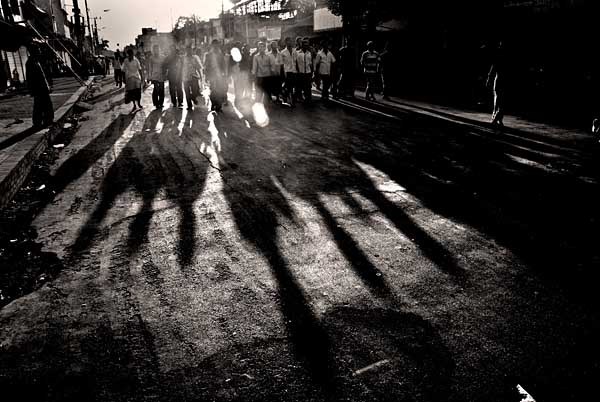
Workers protest on the streets of Khalishpur, even during emergency. ? Munem Wasif/DrikNews
A child screams.
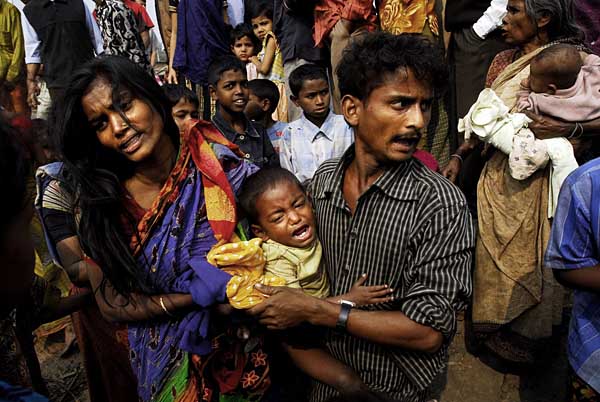
Soon after coming to power, the caretaker government ordered all illegal constructions and slums be torn down. Those affected do not know where to find shelter since laws and their interpretations are mostly anti-poor. Dhaka Bangladesh. 24 January 2007. ? Munem Wasif/DrikNews
Evicted from a slum that offered little, his parents in search for even less.
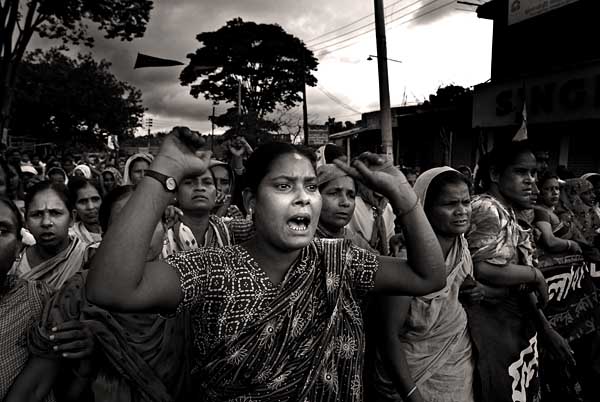
Muslim and Adivasi women unite in their fight against multinationals. Phulbari Bangladesh. 30 September 2006. ? Munem Wasif/DrikNews
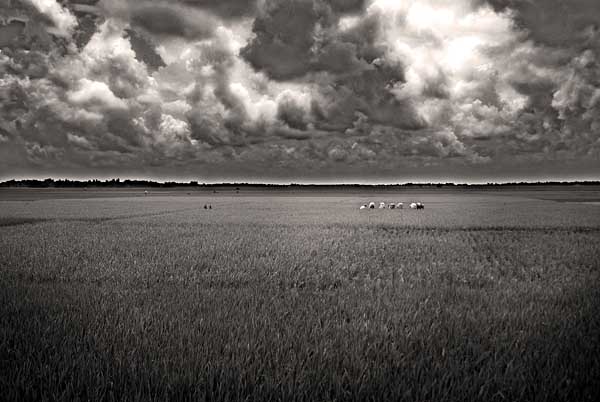
These green fields will disappear if coal mining starts. Phulbari Bangladesh. ? Munem Wasif/DrikNews
Angry women protest the illegal hand-over of their land to multinationals.
————————————-
Choles Ritchil killed in custody
————————————-
And the missing photograph. The one we cannot show. The one of the Adivashi leader tortured and killed in custody. He too had the temerity to resist government takeover of his ancestral land.
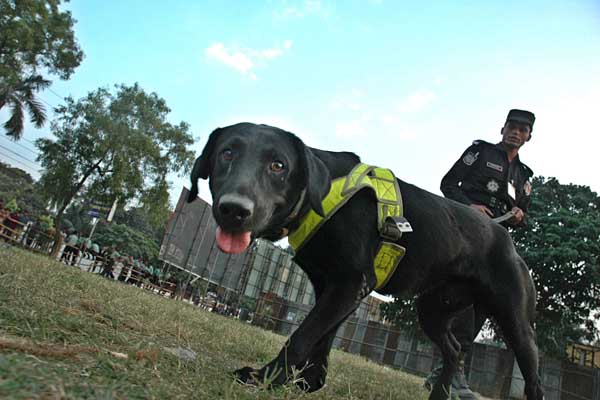
A member of Rapid Action Battalion (RAB, Bangladesh’s elite security force), checks the grounds with a dog squad to ensure security of the 14 party led Awami League’s grand rally the next day. Paltan, Dhaka Bangladesh. December 17 2006.
? Munir uz Zaman/DrikNews
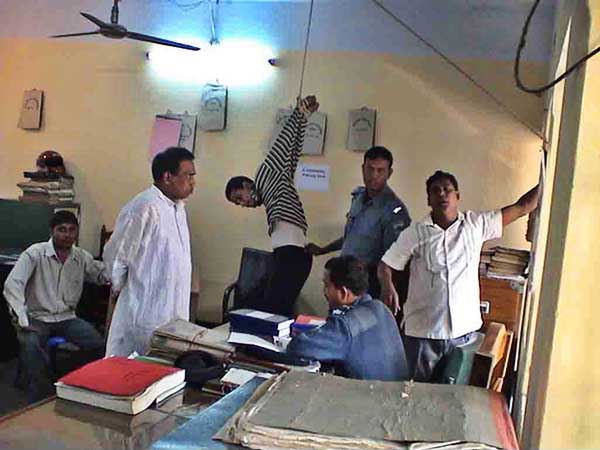
Ratan Kumar, suspected of stealing a gold necklace, was tortured at Bogra Police Station. This photograph (taken with a mobile phone) was published in a daily newspaper, resulted in police officials seen in the picture (the officer-in-charge, three sub-inspectors and a constable) being suspended from active duty. Bogra Bangladesh. 28 January 2007. ? DrikNews

Police fired tear gas shells and rubber bullets to stop agitated students at Dhaka University campus. As protests engulfed the nation, curfew was declared in 6 divisional cities from 8 at night. A student hurls back a tear gas shell. Dhaka Bangladesh. 22 August 2007.? Azizur Rahim Peu/DrikNews
Now is a difficult time. A time for reflection, a time for retrospection, a time for defiance. Sadly for most Bangladeshis, now has always been difficult. Apart from the brief euphoria after independence in ’71, there were the lesser joys when the autocrat left in ’90, on winning a Nobel peace prize in ’06 and even temporary relief when emergency was declared in January ’07. But those feelings have been short-lived. Particularly for the poor. When elephants clash it is the grass that gets hurt.
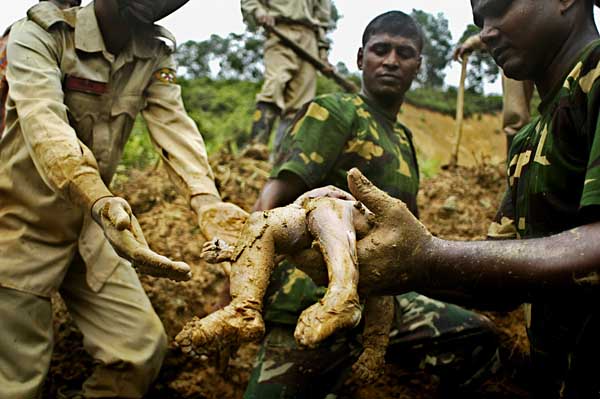
Soldiers and rescue workers recover a child’s body from landslides caused by heavy rains on the deforested hills of Chittagong city. One hundred and six people died, many more were injured. Chittagong Bangladesh. 12 June 2007. ? Tanvir Ahmed/DrikNews
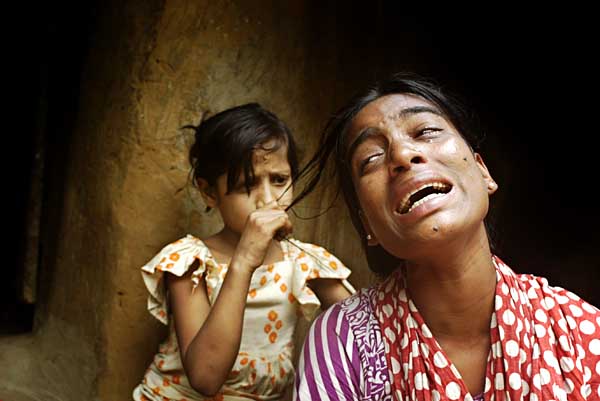
A woman mourns the death of her family members, all of whom died as a result of the mudslide. Chittagong Bangladesh. 12 June 2007. ? Tanvir Ahmed/DrikNews
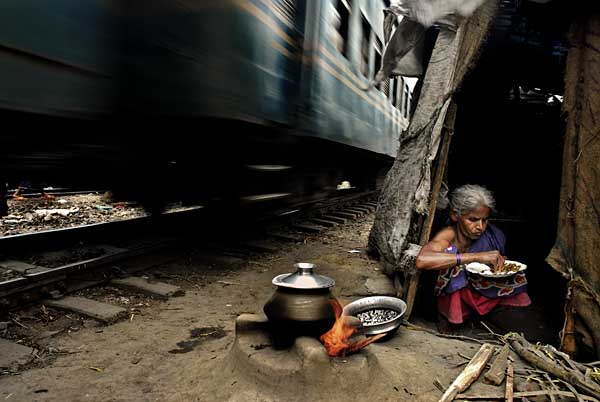
Life is fearful for a slum-dweller. When will she face the next eviction? Dhaka Bangladesh ? Munem Wasif/DrikNews
Arrests in the night, the brutality of high prices and the daily grind of poverty are the realities that wear people down. But they are warriors. Despite the weight of unjust governance, despite the price they always end up paying, they still protest. And the photojournalists? When justice is compromised. When the poor are trampled under the march of ‘reform’. When fear evokes silence. When familiar faces turn away. To stay ‘neutral’ is to stay aloof. They stand on the side of the oppressed. Unashamedly so.
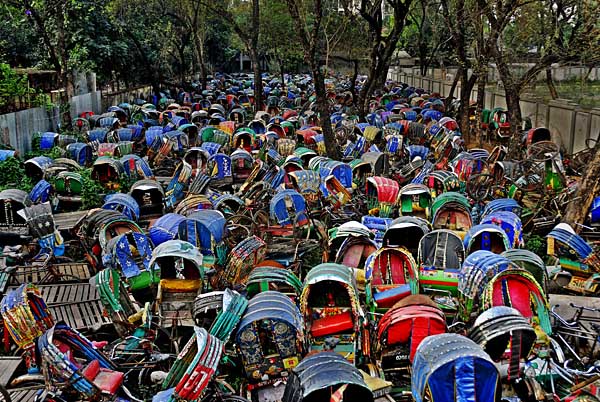
Rickshaws without proper licenses seized by police and dumped near Police Control room. Rickshaws are environment-friendly and affordable by the middle class and often the only source of paid work for men migrating from villages in search of work. 17 February 2007. Dhaka Bangladesh. ? Munem Wasif/DrikNews
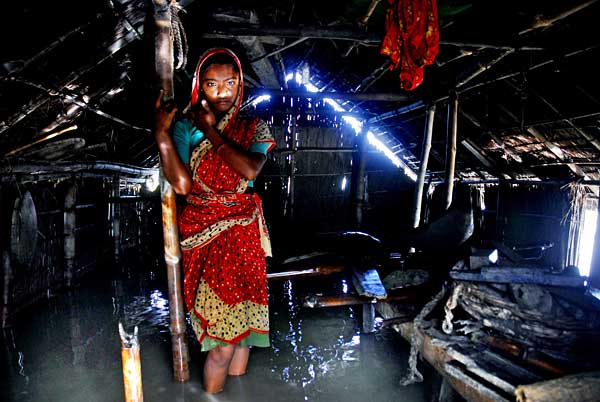
A village woman dries dhan (husked rice grain) as flood waters recede. Chilmari, Rangpur. August 8 2007. A village woman dries dhan (husked rice grain) as flood waters recede. Chilmari, Rangpur. August 8 2007. ? Munem Wasif/DrikNews
On Tuesday the 4th of September 2007 DrikNews will hold its inaugural photographic exhibition “Bangladesh Now”. The photographs shown are a selection from the exhibition.
The exhibition will be opened by Nurul Kabir, editor, New Age, who will share his views about the current situation in Bangladesh,
before the opening. The program starts at 5.00 pm.
Drik will be 18 years old on that day. We’d like you to be with us
The Barren Banana Tree
![]()
Singapore Airlines warned of “protests by university students developing in Dhaka” as we boarded the plane. But emails from Delower and Rahnuma during the brief stopover in Singapore talked of the curfew in place in the six main cities. This was no longer a small skirmish in Dhaka University. Joshim was going to be at the airport with my accreditation card and we would try and find a way back home.

Students at Dhaka University under teargas attack, throwing bricks at police. 22 August 2007. Dhaka Bangladesh ? Munir uz Zaman/DrikNews
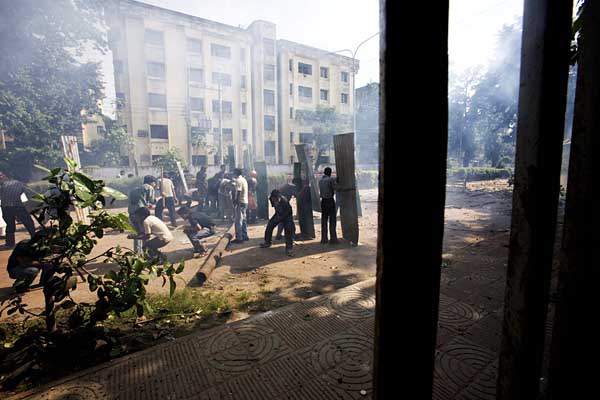
Students at Dhaka University shielding themselves with sheets of tin, during fights with police. Photographer anonymous.
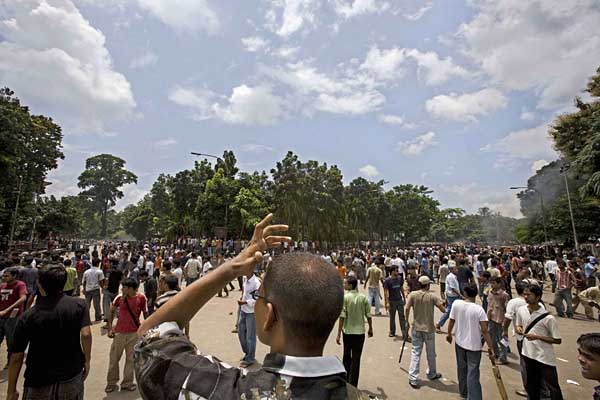
Protesting students gather at Dhaka University campus during violent clashes with police. Photographer anonymous.
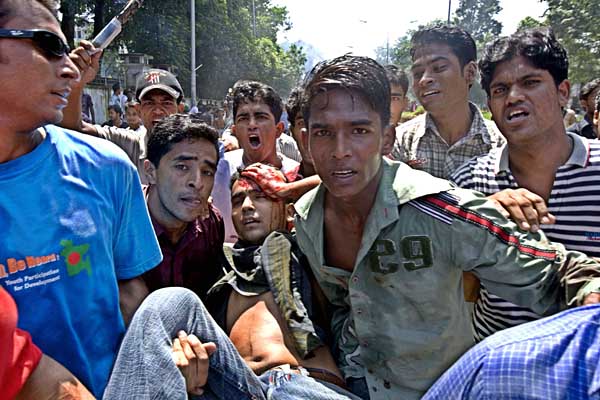
Student hit by police shotgun bullet being carried away by fellow students. Photographer anonymous.
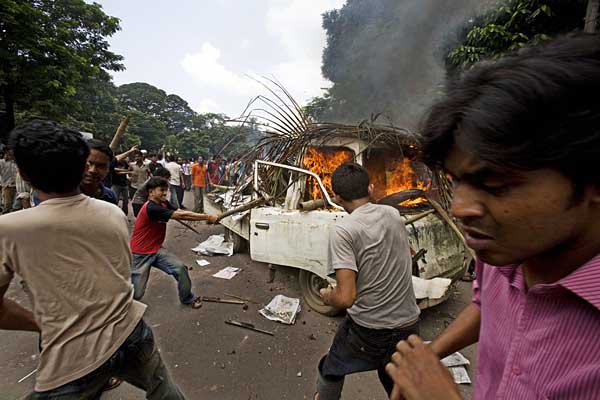
Enraged students burn a car at the Teacher’s Student’s Centre (TSC). Photographer anonymous.
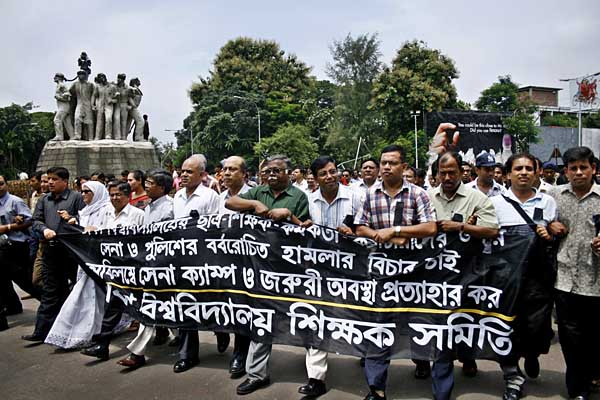
Members of Dhaka University Teacher’s Association protesting against the attacks on campus by police and army, and demanding withdrawal of the state of emergency. Two of the teachers in the front row have since been arrested. 22 August 2007. Dhaka Bangladesh ? Munir uz Zaman/DrikNews
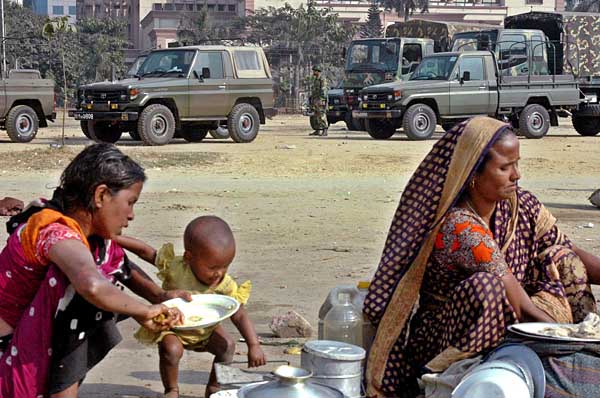
Rocketing prices of essentials create extreme distress for people with low earnings, like the people pictured in the foreground. The military of Bangladesh, which has not had to fight since the birth of the nation in 1971, has in the meanwhile, had increasing budgetary allocations in each successive regime. Numerous allegations about corruption in military purchase, has gone uninvestigated. 22 August 2007. Dhaka Bangladesh ? Munir uz Zaman/DrikNews
The government had taken all mobile networks off the air. With only official press releases for information, the person in the street was in for a rough time. It was easy to find Joshim in the empty car park. Only the occasional long distance truck plied VIP road. I put the video camera on record mode, but relied on my less conspicuous LUMIX to photograph the empty streets. Though I stopped on the Mohakhali flyover to take pictures, I was nervous when the RAB vehicles passed below. There was never a good time for being arrested, but this was as wrong a time as it could get.
Aaasteeey! The policeman strode over lazily. Ki bapar? I did have my card dangling from my neck, and from previous experience, used my confident, ‘I belong here’ approach. That usually worked best with low tier security people.
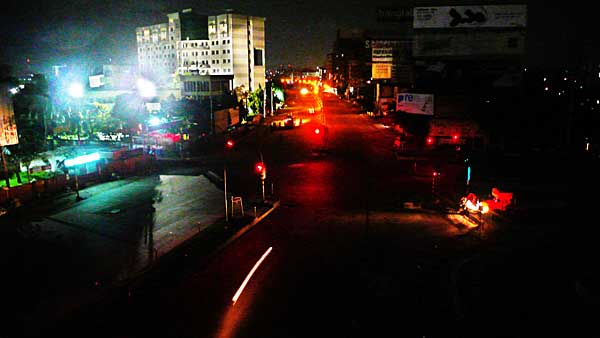
The Mohakhali Junction, one of Dhaka’s busiest traffic spots, is empty on the night of the 22nd August, when the government called an indefinite curfew. Dhaka Bangladesh. ? Shahidul Alam/Drik/MajorityWorld
I’d stopped to take pictures by the near-empty Tejgaon rail station. Stepping carefully through the people sleeping on the floor, I came up to Shahjahan and Neela. Unaware of the curfew, they had brought their sick child Shamim from Tangail, but got stranded in Tejgaon. There was no food, no doctor, no place to sleep, no way of knowing how long this would go on. Each visit to the toilet cost 5 Taka.
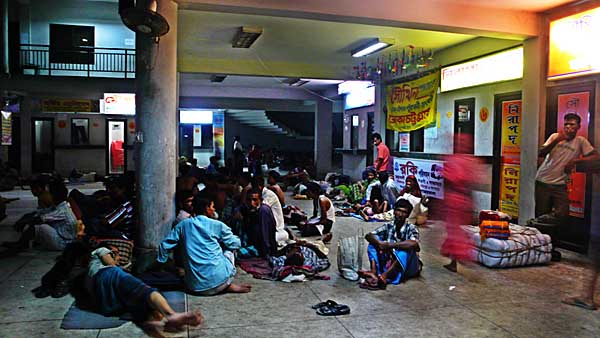
Stranded passengers at Tejgaon Railway Station, sleep on the floor. 22 August 2007. Dhaka Bangladesh. ? Shahidul Alam/Drik/MajorityWorld
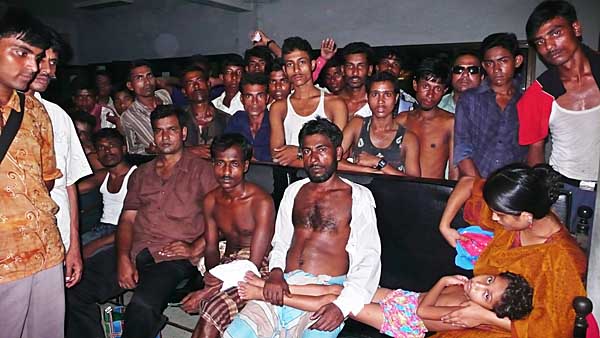
Shahjahan and Neela tend to their sick child Shamim, whom they had brought to Dhaka for treatment. Along with other stranded passengers at Tejgaon Railway Station, the family had no food or drink, or a place to sleep. 22 August 2007. Dhaka Bangladesh. ? Shahidul Alam/Drik/MajorityWorld
The next checkpost was slightly more hostile, but the expired accreditation card dangling from my neck was working overtime. We passed without much harassment. Dropping Joshim home, I went past the Shonar Bangla Market in Karwan Bazaar. The busy market place had a haunted look. No cackle of chickens, haggling for prices, or calls from vendors. Just one man counting loose change.
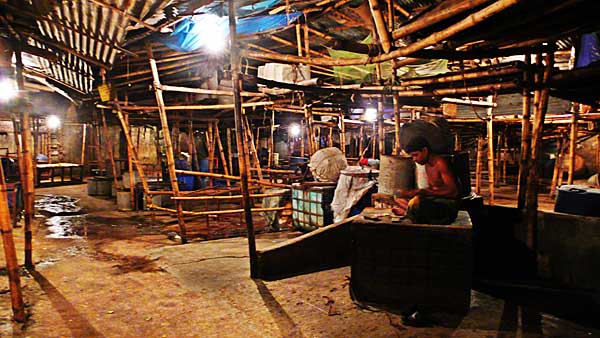
Shonar Bangla Market at Karwan Bazaar is one of the busiest market places in Dhaka. The shops are empty on the night of 22nd August 2007. Dhaka Bangladesh. ? Shahidul Alam/Drik/MajorityWorld
The brightly lit Square Hospital in Panthapath stood out in the dark. Government orders to turn down the lights after dusk to save electricity was presumably for commoners only. The street was empty, but this time as I approached with my camera police converged from all directions. I fumbled a bit, but recovered in time to get one shot. This was not the time to look for best angles. Rattling off important sounding words like ministry of information, and dropping the occasional names I could think of, I got into the car and drove off before the uniformed men had gathered their wits. A government adviser’s business interests in Square Pharmaceuticals – while undeclared – was well known. Students had already attacked the building the previous day. The approaching police knew whose business interests to protect.
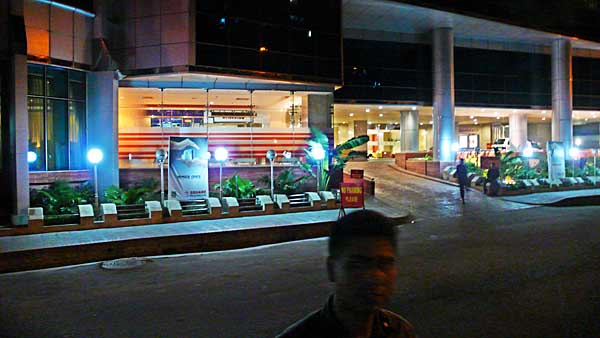
The Square Group, one of the wealthiest business enterprises in Bangladesh owns the Square Hospital. Government regulations prohibit the excess use of electricity and non-essential shops are required to close by 8 pm. Several people were killed by the police when they came out in protest, demanding adequate electricity. The Square Group is owned by the family of one of the advisers of the caretaker government. 22 August 2007. Dhaka Bangladesh. ? Shahidul Alam/Drik/MajorityWorld
The road through Dhanmondi was eerie. The women who walked the streets near Abahani playground were nowhere to be seen. Like the many others who struggled to make a living, they too would not be earning tonight.
The junction near ULAB was scarred by burnt tyres. The convoy of police vans deterred me from getting my camera out and I turned into road 4A. It was time to go home. Kamaler Ma, Joigun, Zohra and Rahnuma were all up waiting. With the mobile network off, they didn’t have any news about me. There must have been others in many more homes who were up worrying.
Rahnuma and I talked of the events over the last two days, of the army camp in Dhaka University. Of a soldier slapping a student. Of the vice chancellor (acting) being beaten up by police. This had never happened before, not even during the Ayub or Ershad military regimes. The reference to ‘evil doers’ in the chief adviser’s speech to the nation was worryingly close to the ‘axis of evil’. Independent media channels were then still defiant. That night the information adviser advised the media to practice ‘self censorship’.
Despite their claims, this government had never been called in by the people. We had no say in who the advisers would be. It was not military rule the people had welcomed, but the cessation of violence and the fear of further anarchy if the rigged elections were held. Banana trees would have made equally good replacements. However, banana trees would not have sold national interests. Closed down environmentally-friendly jute mills. Made slum dwellers homeless, or tortured and killed adibashis protesting the military acquisition of their ancestral lands. So while there was initial relief, as the price of essentials soared, news of nepotism and the partisan manner in which Jamaat -e-Islami was being shielded soon made people realise this banana tree would never bear fruit, let alone run a government.
Warrantless arrests by plainsclothes army under the cover of curfew. Dissenting teachers picked up in the middle of the night. Making threats to independent channels ETV and CSB are hardly the character of a saviour government pledged to the return of democracy. As the behind-the-scene military decides it will now take centre stage. As Bangladeshis realise that a democratically elected autocratic government has simply been replaced by an unelected autocratic one, the tune in the streets is changing.
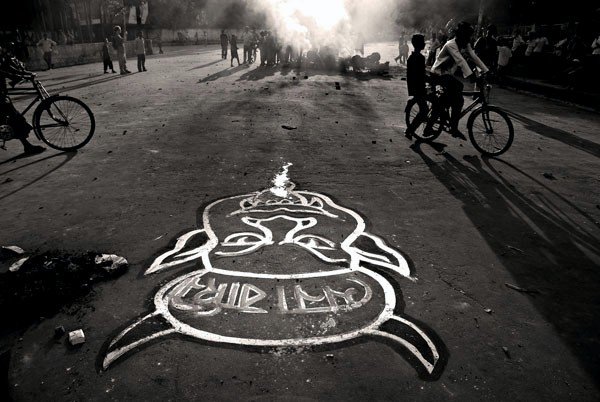
Symbols of fascist oppression drawn on university road. 21st August 2007. Dhaka Bangladesh ? Munem Wasif/DrikNews
Multiple demands of students and teachers have been whittled down to one – withdraw emergency rule. Underground pamphlets are spreading like wildfire. With the Internet down, text messages are filling up the ether. The information adviser’s suave statements to the media faltered as he snapped, “why such a fuss about a slap or two?”
****
The photograph that was being shown here has been removed on the request of the photographer
****
“In unprecedented scenes, soldiers in uniform were seen being chased out of the Dhaka university campus by students. In two days, the myth of the army’s omnipotence was all but laid to rest.” BBC. Photographer Anonymous.
The US has declared support for the chief adviser’s statement. What he lacks is the support of the people.
The Price of Peace
![]()
I am the rage I am the storm
My path I leave barren and shorn
Swaying in my crazy dance
I rejoice at all I face
Move at my own pace
I grapple my foe
I wrestle to die
I am the warrior, head held high*
He was a dreamer, a rebel, a lover, a poet. He moved strong men to tears and woke a nation to unite against tyranny. The British imprisoned him only to find his pen spewing venom from the prison cell. Yet, Kazi Nazrul Islam was a romantic, and his lilting songs, magical stories and even his fiery verse did more to bring together Muslims and Hindus than any peacemaker had ever done. The poor turned away from God?s door, the lover spurned, the weak, the meek, the downtrodden, all found refuge in his words and his music. Unlike the literary giant of the time – Tagore, Nazrul was uncompromising. He spoke of strife, and the peace of acquiescence was never his mettle. Mixing Persian, English and Hindi with his majestic repertoire in his native language Bangla, Nazrul called a nation to war against its occupiers, but also spoke out against the tyranny of religion and class. It was his haunting love songs however, that made Nazrul inimitable. Living the life he preached, he refused to conform. Marrying outside religion, shunning material comfort, and eventually rejecting our carefully defined sanity, he rebelled against a peace that required the acceptance of the status quo. Conflict was his muse.
Lalon, long before him, had traversed a very different terrain. The journey between the body and the soul. The metaphors of the bird and the cage, with the soul flirting with the body, elusive. tantalizing and ever so ephemeral. The sufi saint dealt with the conflict between the material world and the spiritual realm. But for Bangladeshis it wasn?t Tagore or Lalon or even Nazrul, but the struggle for language itself that galvanized the nation. Separated from India on the basis of religion when the British were forced to leave, East Pakistanis had always felt exploited by the West wing and discontent had been brewing, but it was when Jinnah declared that Urdu would be the national language of Pakistan that people took to the streets. The violent birth of Bangladesh, gave a nation with its own language, but Bangali nationalism too became the oppressor of other cultures and the indigenous people of the Hill Tracts have been brutally reminded ever since that they are the other. Their peace could only be earned at the cost of their identity.
Surendra Lal Dewan, was sad that his song had been stolen by the president, but that was not what pained him most. As director of the Tribal Centre in Rangamati, he was required to bring out Pahari women dressed in ethnic garb at regular intervals. They would dance in bright tribal costumes for tourists, visiting dignitaries and even curious Bangalis whenever the state needed to demonstrate Bangladesh?s tolerance and its ethnic diversity. In his song Dewan had spoken of a Bangladesh free of oppression and torture. That a military general, claiming the song to be his own, would use the same words to chant of an egalitarian Bangladesh pierced Surendra with his own words.
Even the naked halogen lamp that shone on the creaky planks that made up the stage near Ispahani Gate 1 had gone. It was the port town of Chittagong and there was no electricity. It didn?t affect Mustafa Kamal and the UTSA theatre group. A string of candles lit up the actors. The children came up close. Kamal wasn?t involved in national issues. He and his group performed to children and their parents, in the slums around Gate 1, and in many other parts of the country. The plays would talk of HIV/AIDS, dowry and land rights. The team would go out to villages and settle land disputes, or fights over someone?s loss of face, by getting the villagers to enact their strife in public. Their participatory plays used humour, love and the occasional risqu? dialogue to enthrall a rapt audience who found a momentary outlet from their tortured lives. But the plays were not simply about temporary relief. They introduced strategies for dealing with the tensions that built up between the landed and the landless, between the buyer and the seller, but also between friends, relatives and neighours. Kamal understood that conflict was a natural product of relationships. While controversies and grievances resulting from differences in values, competition for resources, or perceived threats, often result in conflict, its mitigation rarely depends entirely upon the solution of the problem, but might only require a release through rituals of protest.
Artificial barriers between nations, illegal occupation of lands, the struggle between the worker and the employer, the exploitation of women and children, and the suppression of minorities generate sparks that might set ablaze communities, and the fires needed to be doused. But there was more to art than being the key to the cage. Kamal worried that while his art might allay the tension, it might, through appeasement – like the empty rhetoric of politicians, like the opium fed to the hungry child, like the comfort assured in afterlife, like the promises of peace by generals – help perpetuate the greater wrong.
Shahidul Alam
Los Angeles
24th May 2007
* Translated and adapted from the poem ?The Rebel? by Kazi Nazrul Islam
Abridged from an essay written for the Prince Claus Fund for the 2007 Award Book on the theme ?Culture and Conflict?.
Kazi Nazrul Islam (b. May 25, 1899 ? d. August 29, 1976 ) was a Bengali poet, musician, revolutionary and philosopher who is best known for pioneering works of Bengali poetry. He is popularly known as the Bidrohi Kobi ? Rebel Poet ? as many of his works showcase an intense rebellion against oppression of humans through slavery, hatred and tradition. He is officially recognised as the national poet of Bangladesh and commemorated in India.
The birth date of Kazi Nazrul Islam, originally recorded on the basis of the Bangla calendar, is considered by some to be the 24th May 1899.
The Trojan Horse
Standing in the grand parliament building in Karachi, built by his grandfather, veteran Pakistani MP Qamar Zaman reflected on the irony of it all. He had long campaigned against the militarization in Pakistan, but recent developments in Bangladesh worried Zaman. ?They saw what went wrong in the Pakistani experiment and decided to fine tune it? he lamented. The election commissioner in India, SY Quraishi, repeated the sentiment. Bangladesh following in Pakistan?s footsteps was not something he welcomed. Kunda Dixit, in Kathmandu, talked of how the same blueprint was being used in all our countries. Despite the rhetoric of democracy, the militarization of South Asian countries was the flavour of the day. Aided by chaotic situations created by political mismanagement, the anti-corruption Trojan Horse brought in its deadly military content.
As in Troy, the people had welcomed them with open arms. Years of mismanagement and corruption had worn down their patience. People wanted respite, regardless of where it came from. This was just the window the military needed. Not wanting to lose out on the lucrative UN placements, they needed a mask. The ?neutral? caretaker government was the perfect foil. The arrests of corrupt politicians, businesspeople and godfathers provided a much needed relief. Few worried about the flimsy, and sometimes concocted accusations used to reel them in. None dared to speak of the glaring omissions. Curbing media freedom took care of the main obstacle. The military or the Jamaat were strangely absent from the list. Amongst the largest and most controversial deals made during previous regimes were the MIG and the Frigate purchases. Yet neither had featured in the cases being investigated. ?kaker mangsho kak khai na.? (A crow doesn?t eat crow?s meat).
After much foot dragging, and over two months of delay, a one member body was asked to probe into the death of adivasi activist Choles Ritchil in the most gruesome killing while in military custody. The Shadarghat launch disaster, in contrast, had three separate investigation committees ordered to submit reports within 24 hours. Choles on the other hand had resisted a multimillion dollar deal to take over adivasi land. It was a different ball game.
Tasneem Khalil was one voice that they had not been able to silence. His incisive, well researched investigations flew against the culture of silence that prevailed. Mahfuz Anam, the editor of the leading English daily, The Daily Star, had proudly told me, ?In all these years, not a single story had been spiked.? That was some time ago. Things were different now. The story of military involvement that Tasneem had revealed was pulled back from the press in the last minute. A commentator on the roundtable at Drik on the 3rd May, International Press Freedom Day, had equated the Daily Star and the Daily Prothom Alo with a new political party. The newspapers had elaborate reporting on the US ambassador’s love for democracy and a free press. The Drik roundtable, featuring some of the bravest journalists working in the land, went unreported. The roundtable had discussed the military, the corporate deals taking place, the heavy hand of foreign countries. It talked of deals being pushed through in the absence of dissent. Tasneem had deliberately not been asked to speak. That would be inviting trouble.
That didn?t protect Tasneem for long. In my room in Shangri La Hotel in the early hours of this morning I received an SMS from a student. Tasneem had been picked up from his home. This is a risk that all journalists speaking against the?government are prepared to take, but given what Choles Ritchil went through, this arrest is more ominous. A suicide note for an epitaph is too likely an outcome to let the system take its course.
Shahidul Alam
Kathmandu
11th May 2007
From SAJA list:
Daily Star reporter (formerly with New Age), and CNN Dhaka stringer, Tasneem Khalil was
picked up by men in plain clothes @ midnight, claiming to be from
“Joint Forces”/Army.
Tasneem Khalil Picked Up By “Joint Forces”
CNN Reporter Picked Up
Tasneem’s Blog
Tasneem, We’ll Come Get You
http://salamdhaka.blogspot.com/
Human Rights Watch Issues Alert
Tasneem on Choles Ritchil Case
Tasneem on Modhupur
Tasneem quoted in Washington Post
Sabash Bangladesh!
On Time Delays
With the characteristic swinging movement of the head interspersed with pendular oscillations that is characteristic of India, Sri Lanka, and to a lesser extent Nepal, Madhav Lohani at the GMG counter in Kathmandu replied, “The flight is on time, but one hour delayed.” While similar, the movement has different meanings in these countries, but the wisdom of Mr. Lohani’s statement removed all ambiguity.
The 12:20 flight which had been rescheduled for 20:20, was now scheduled to depart at 21:20. The TV monitor meanwhile still kept up our spirits with the 20:20 departure time. I was meant to have been traveling on the Biman flight earlier in the day, but that flight too had been cancelled. No one from Biman had been on the counter to explain, so I only learnt of the news when a friendly porter confided in me. Had Mr. Lohani been there, surely his head would have nodded while he said, “The flight is on time but one day delayed.” Continue reading “On Time Delays”
